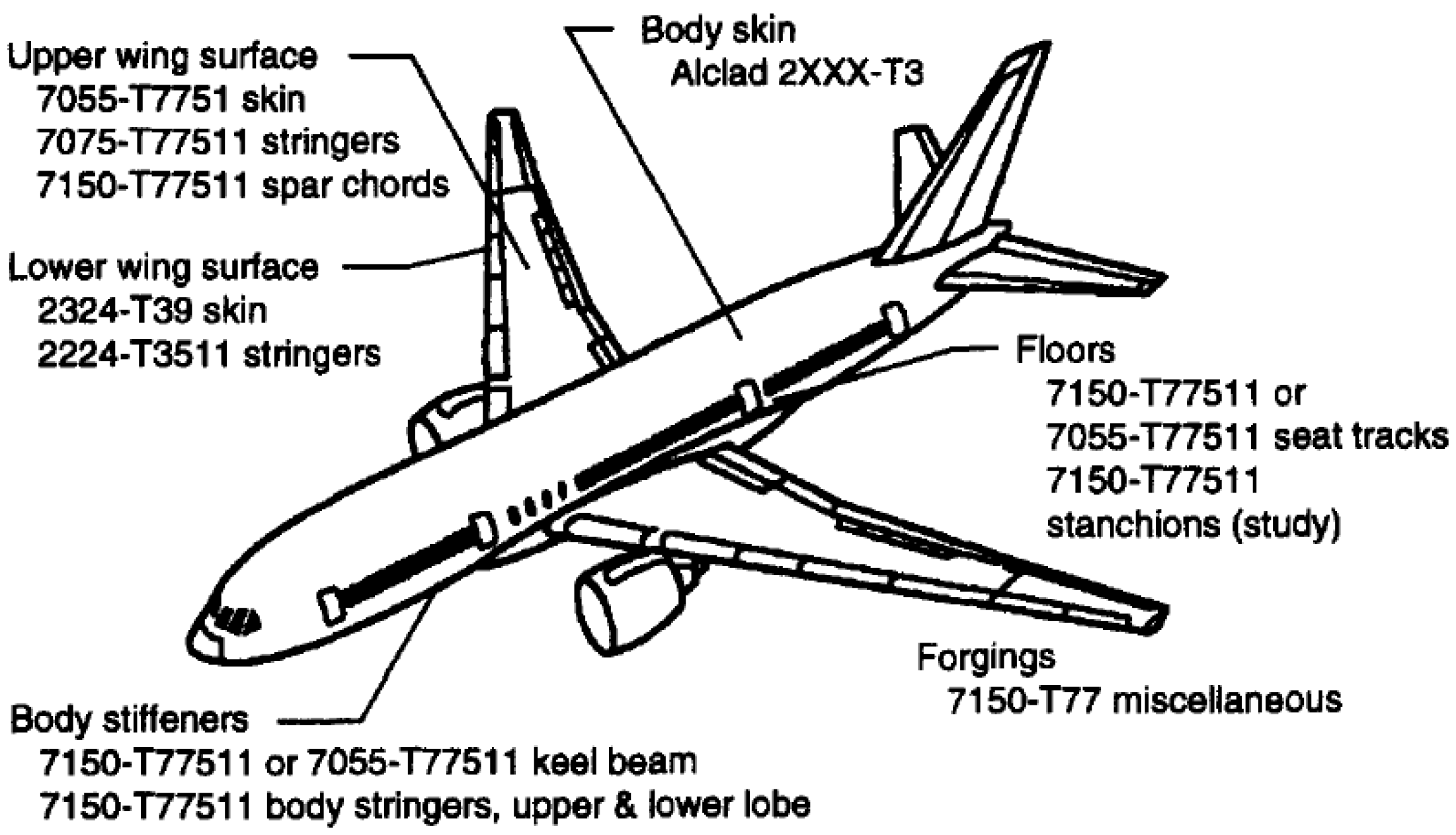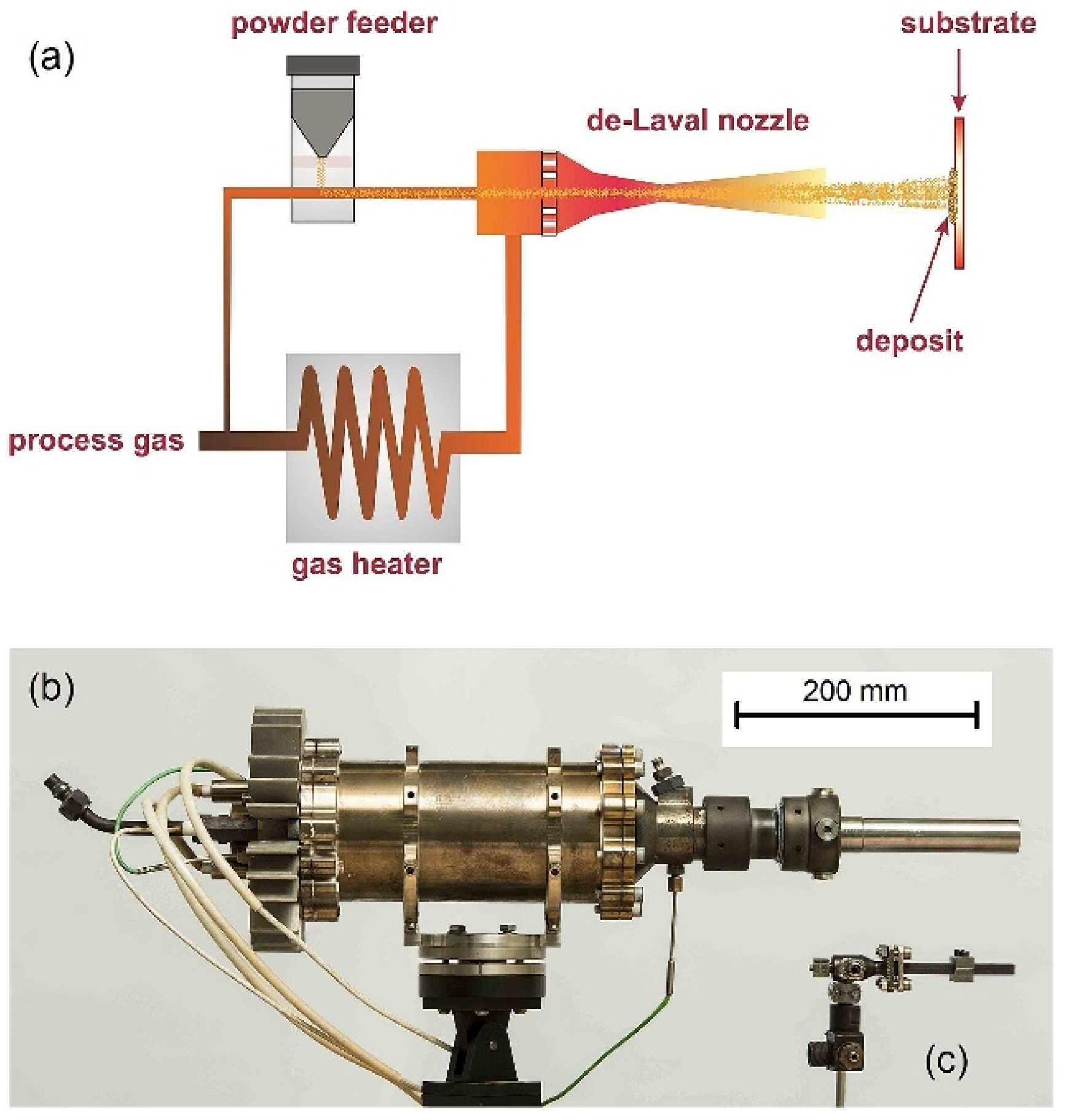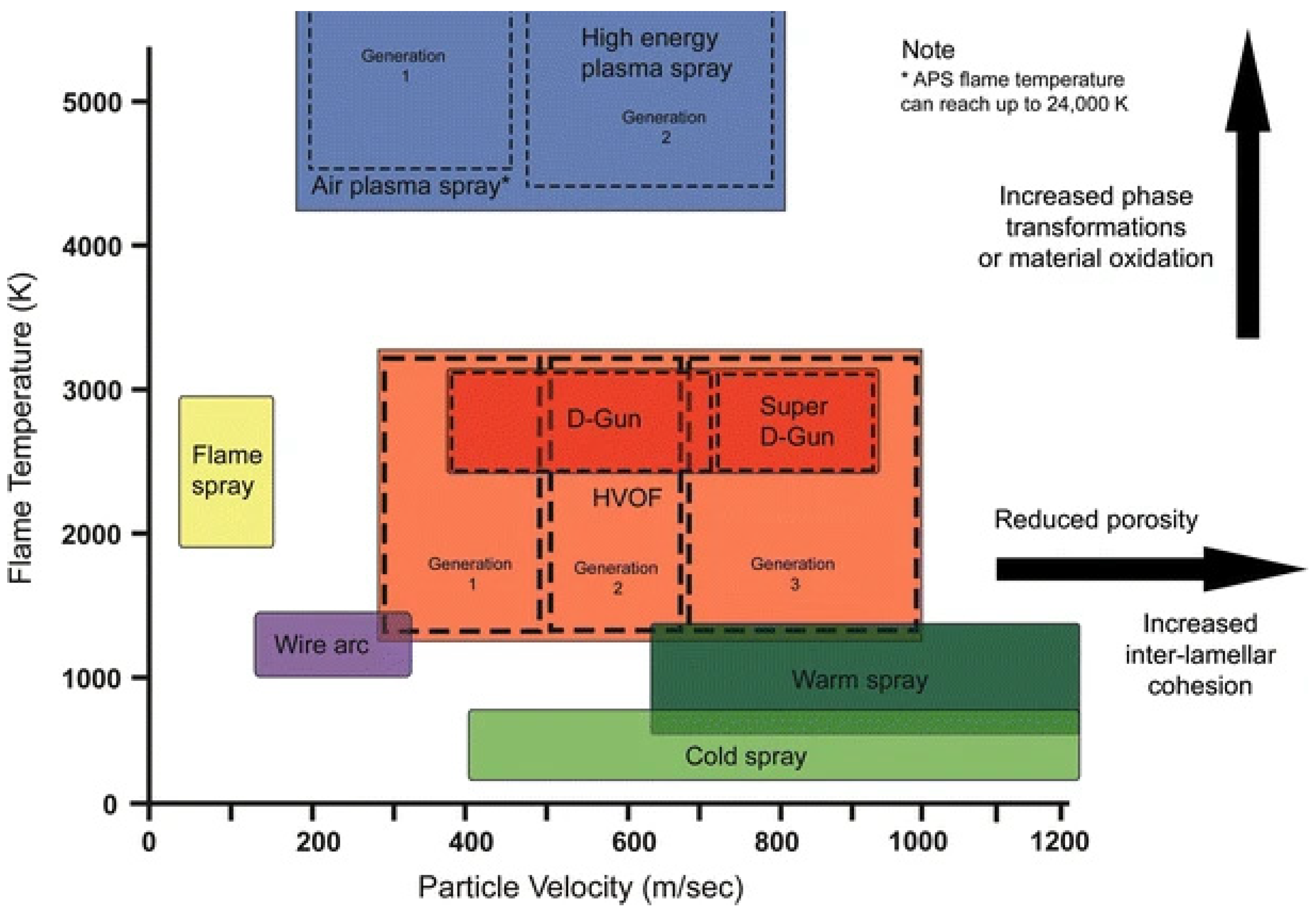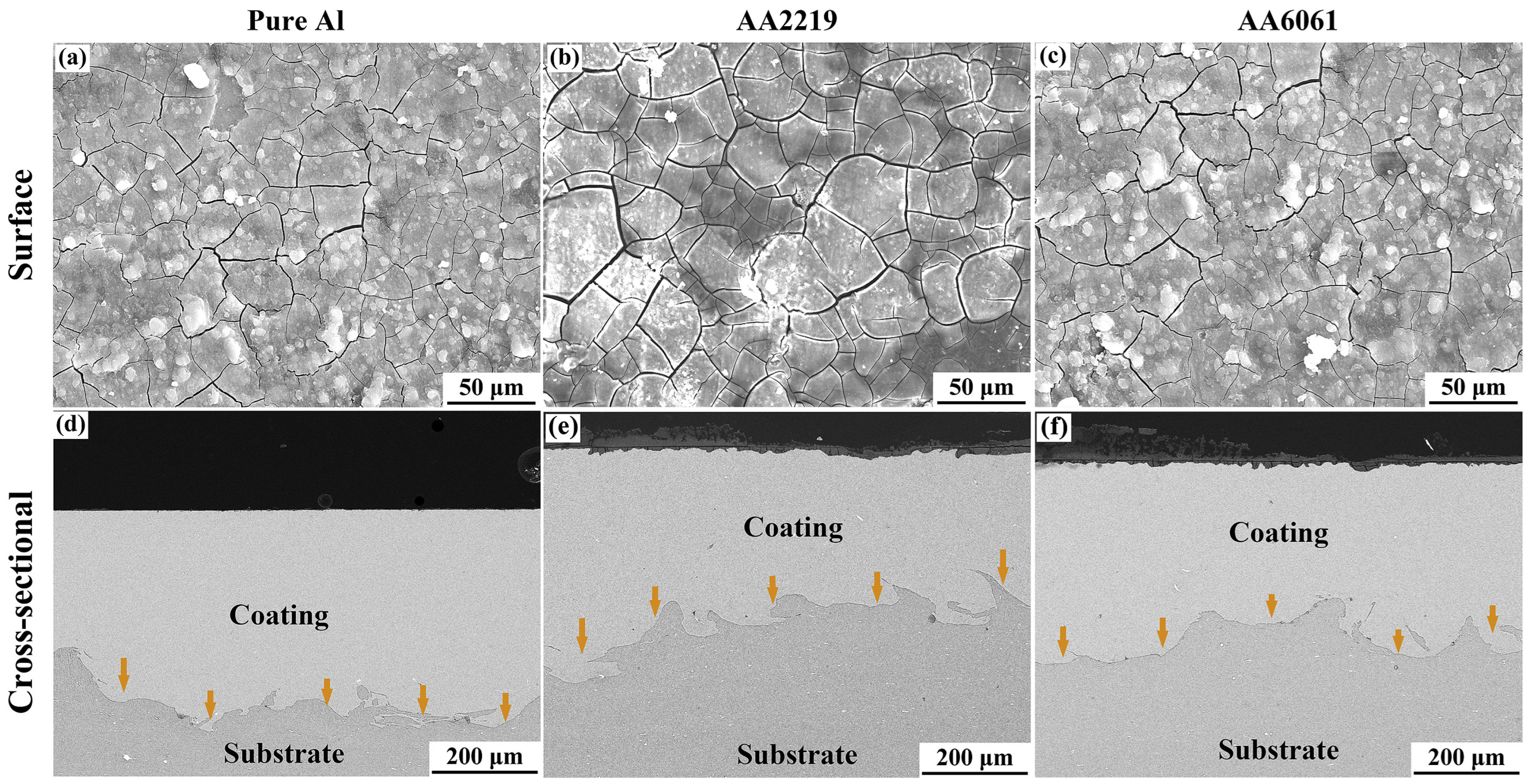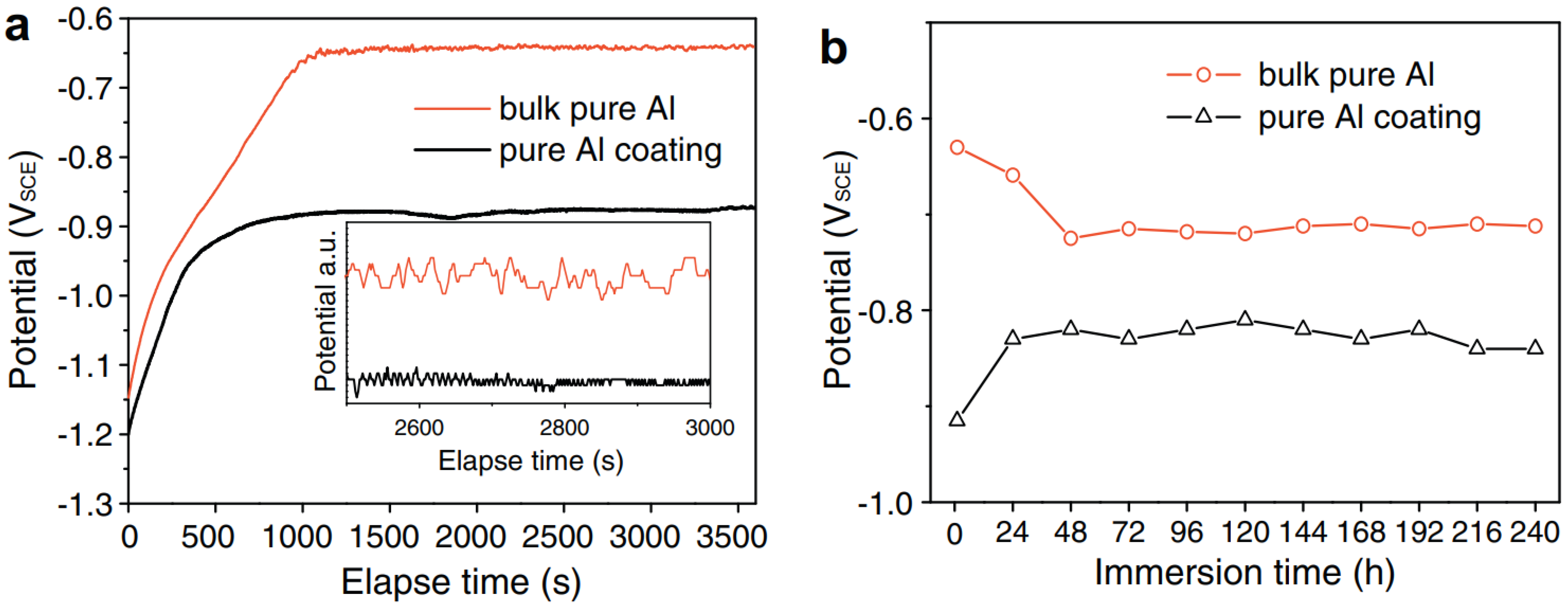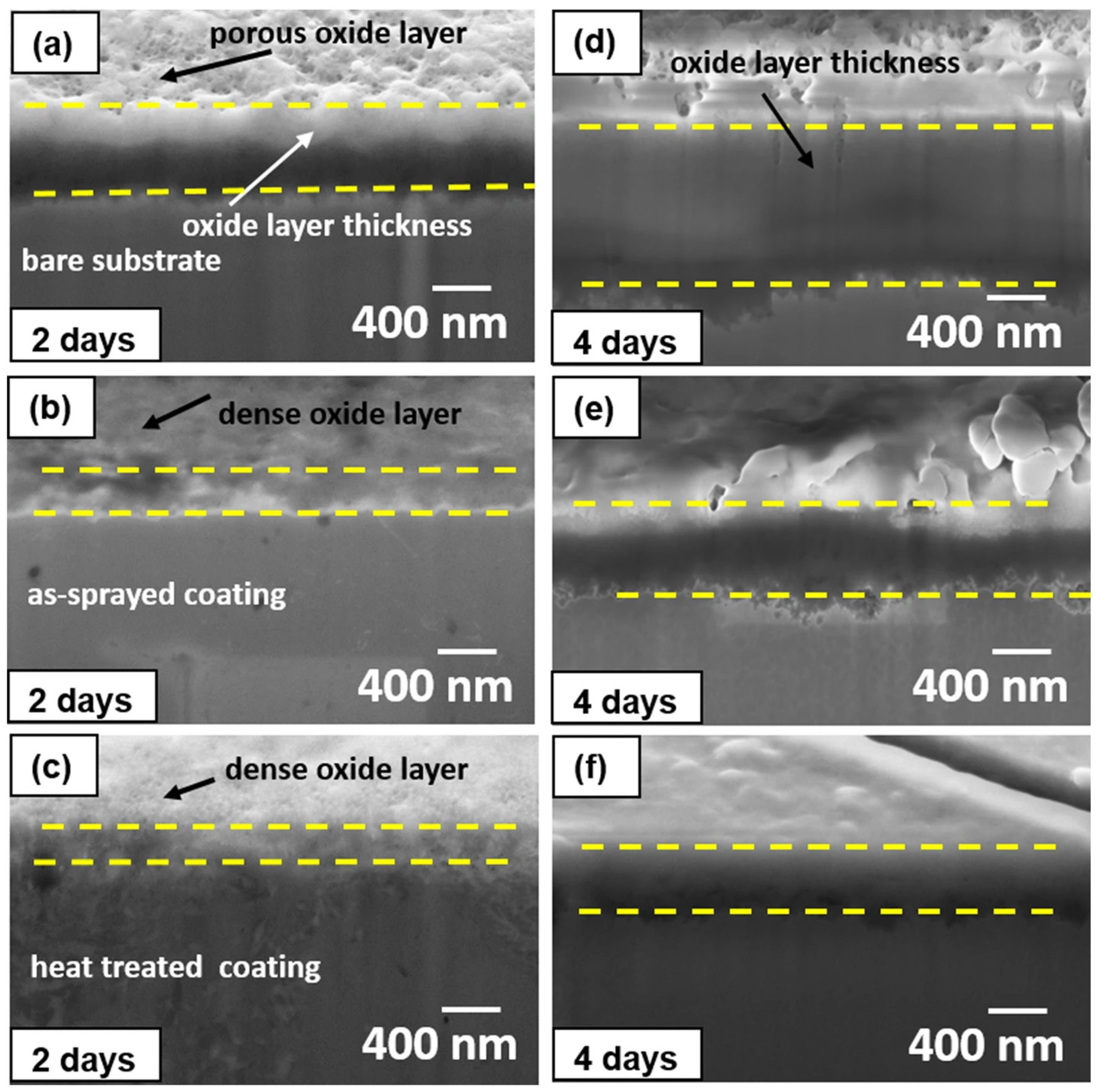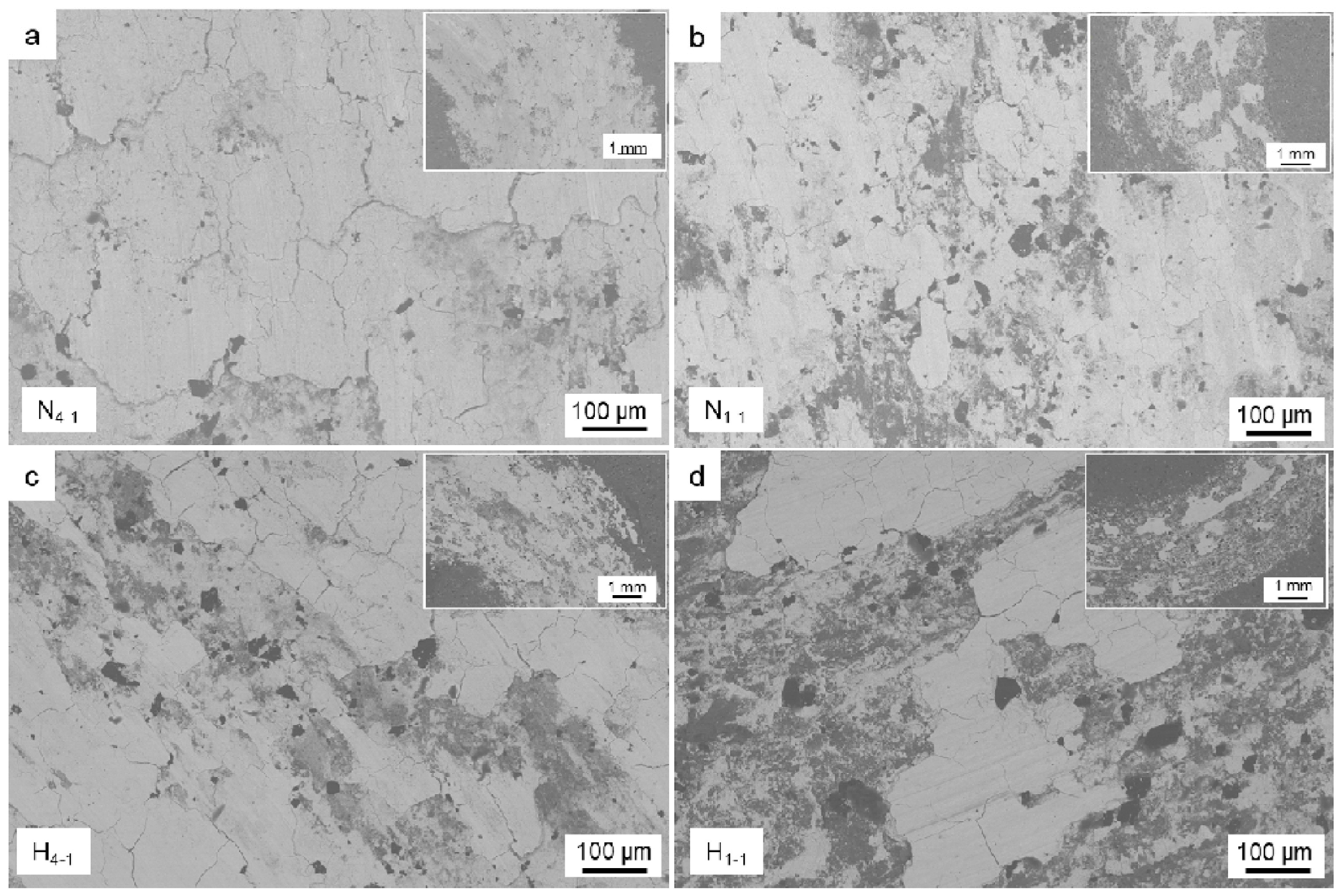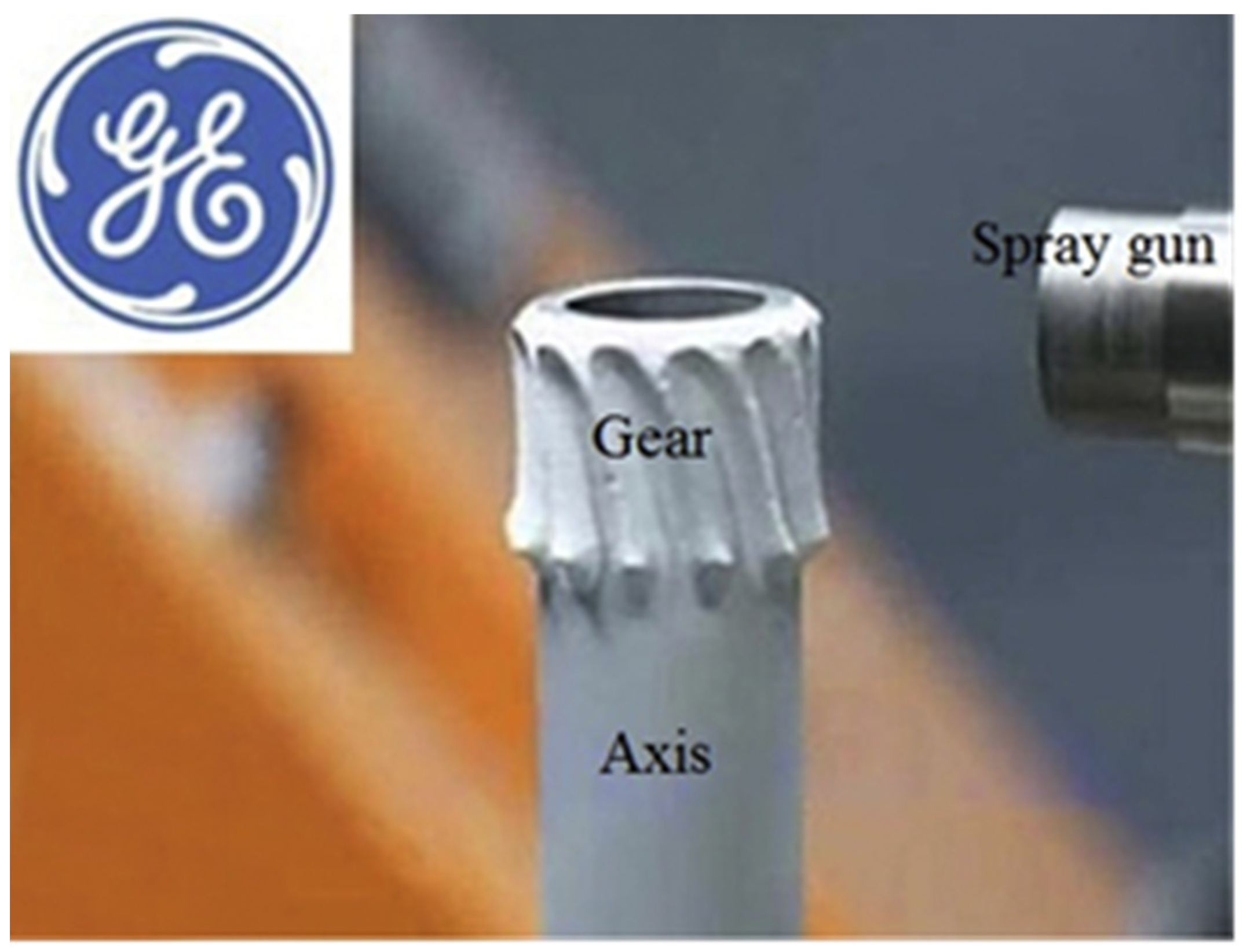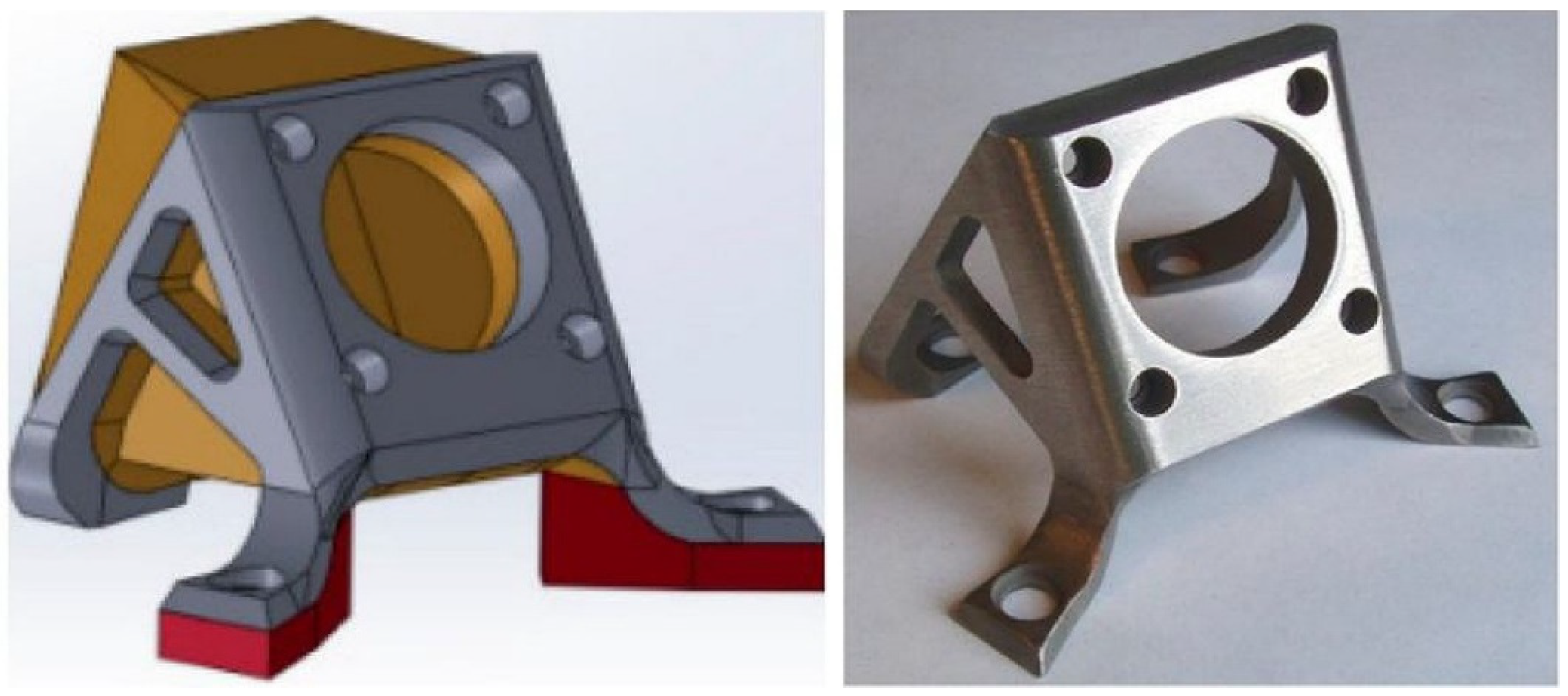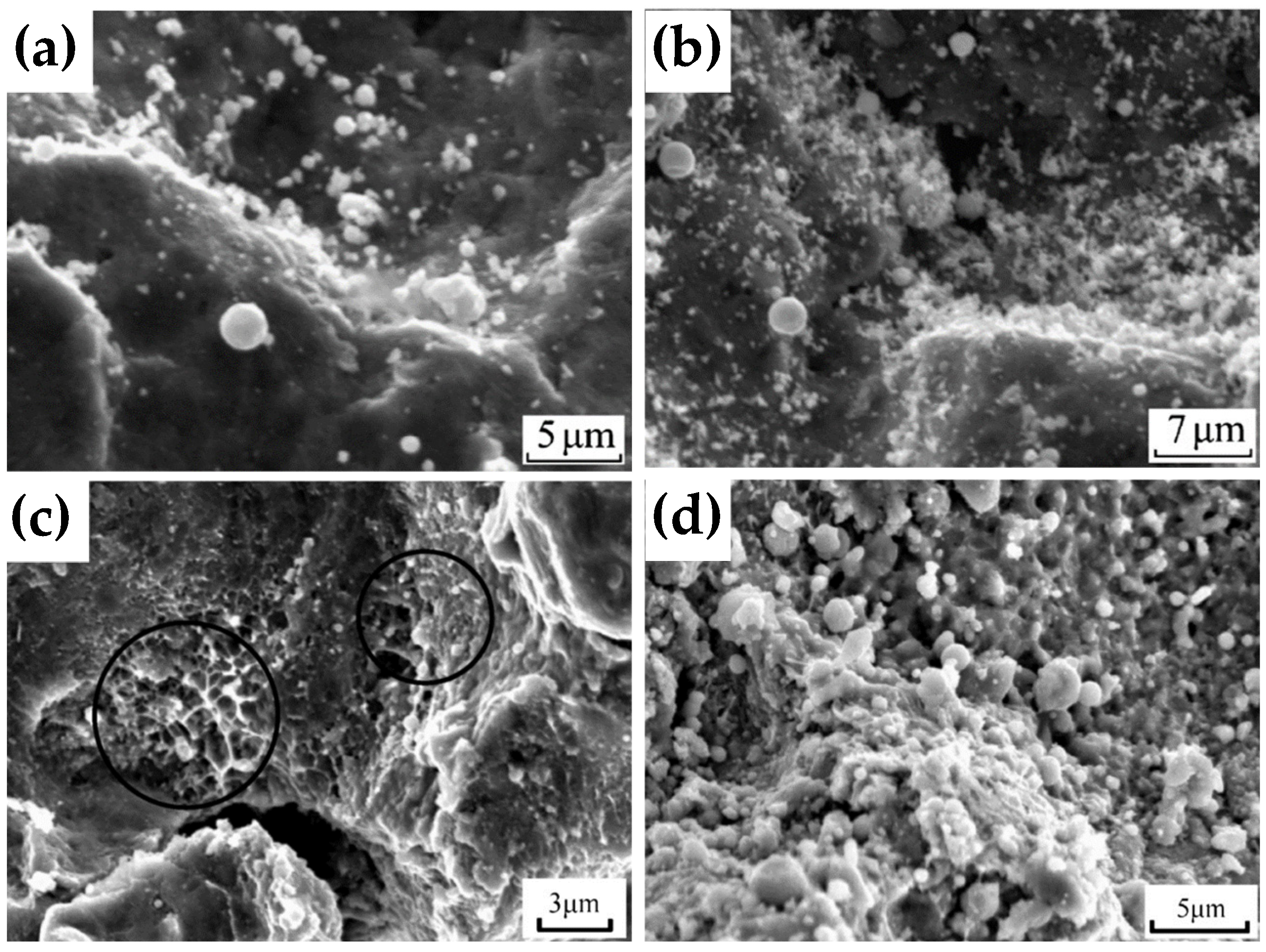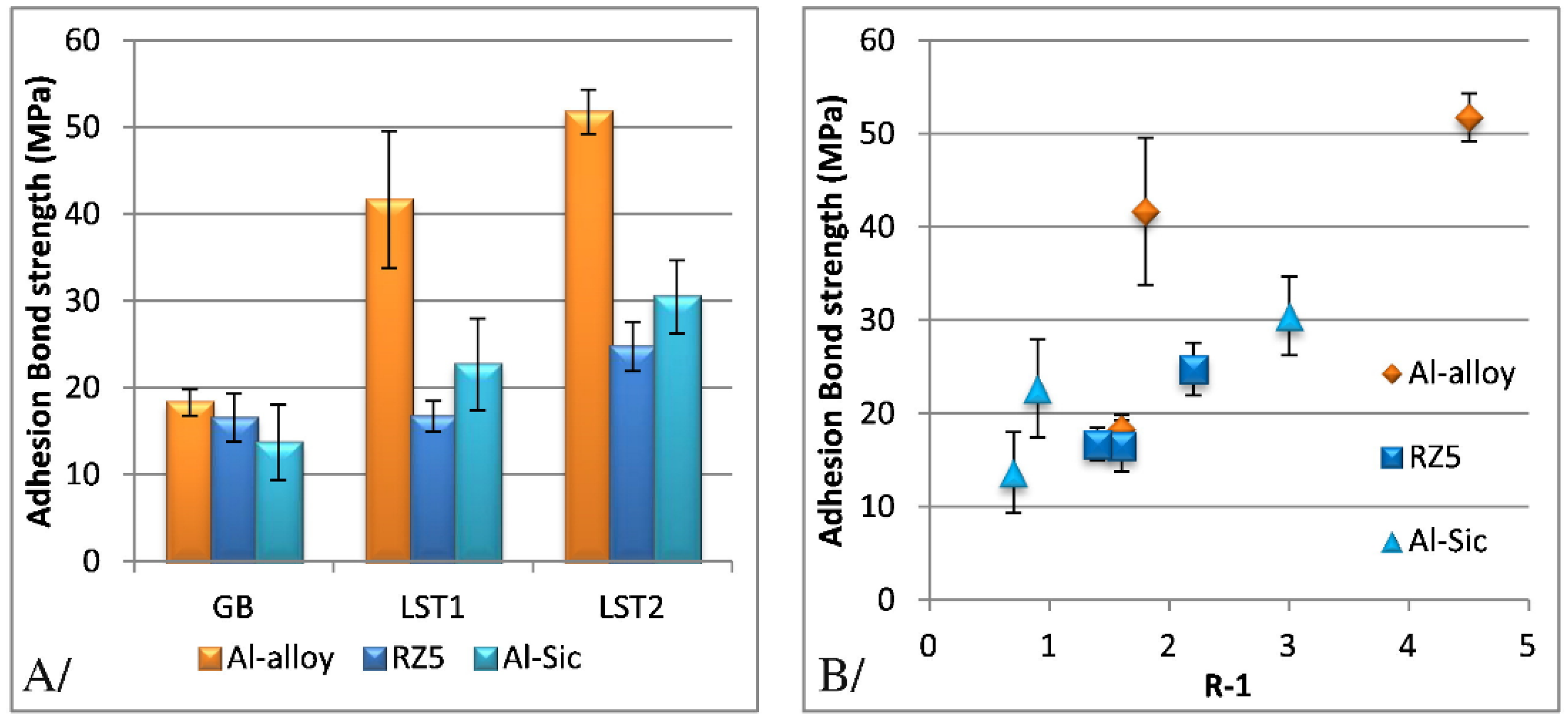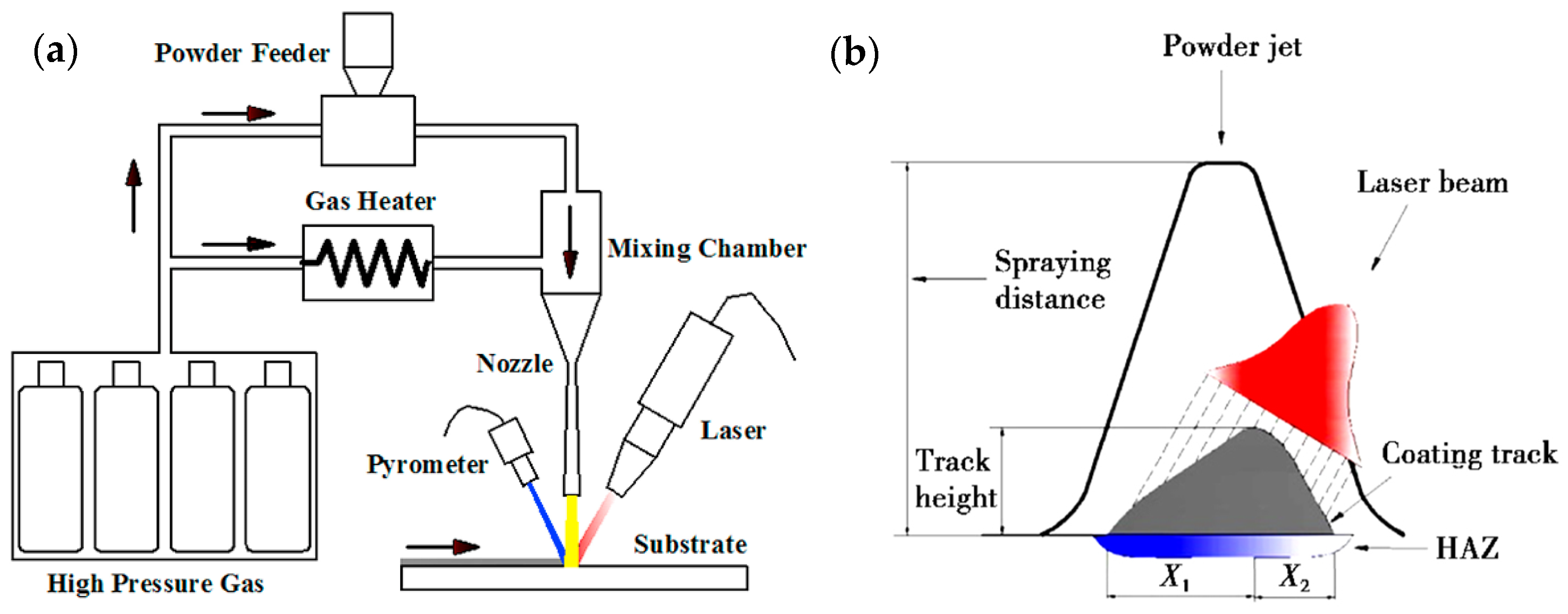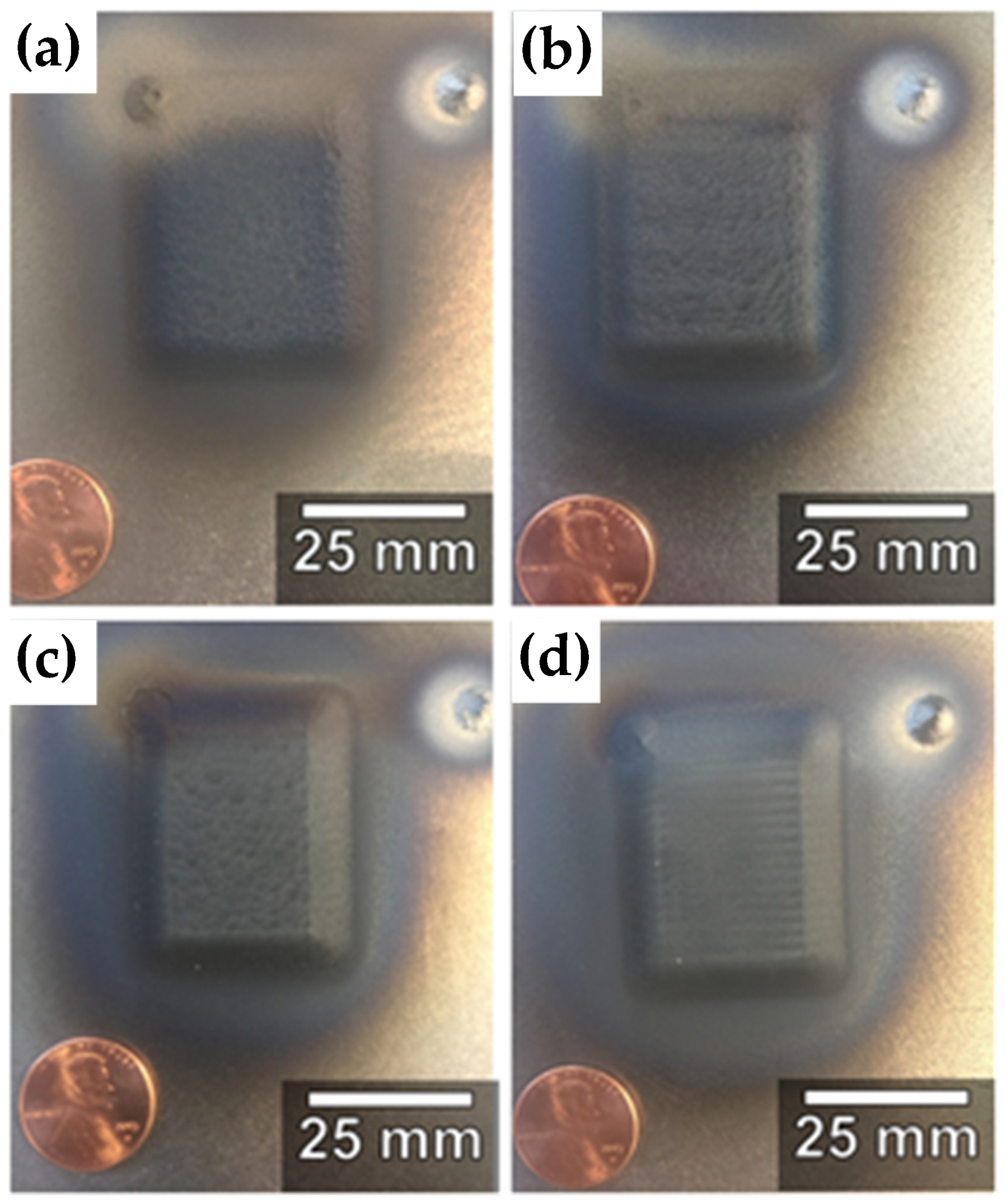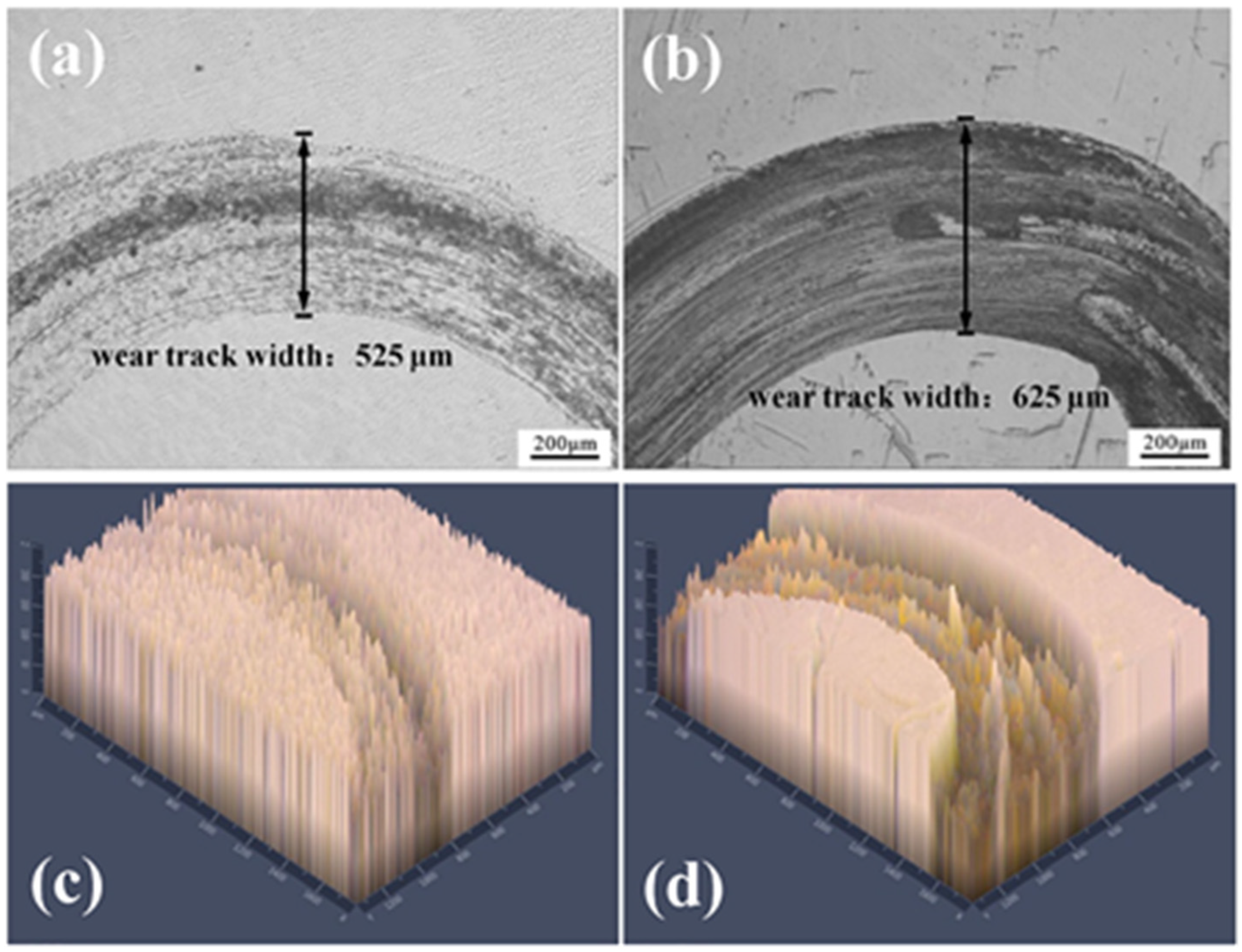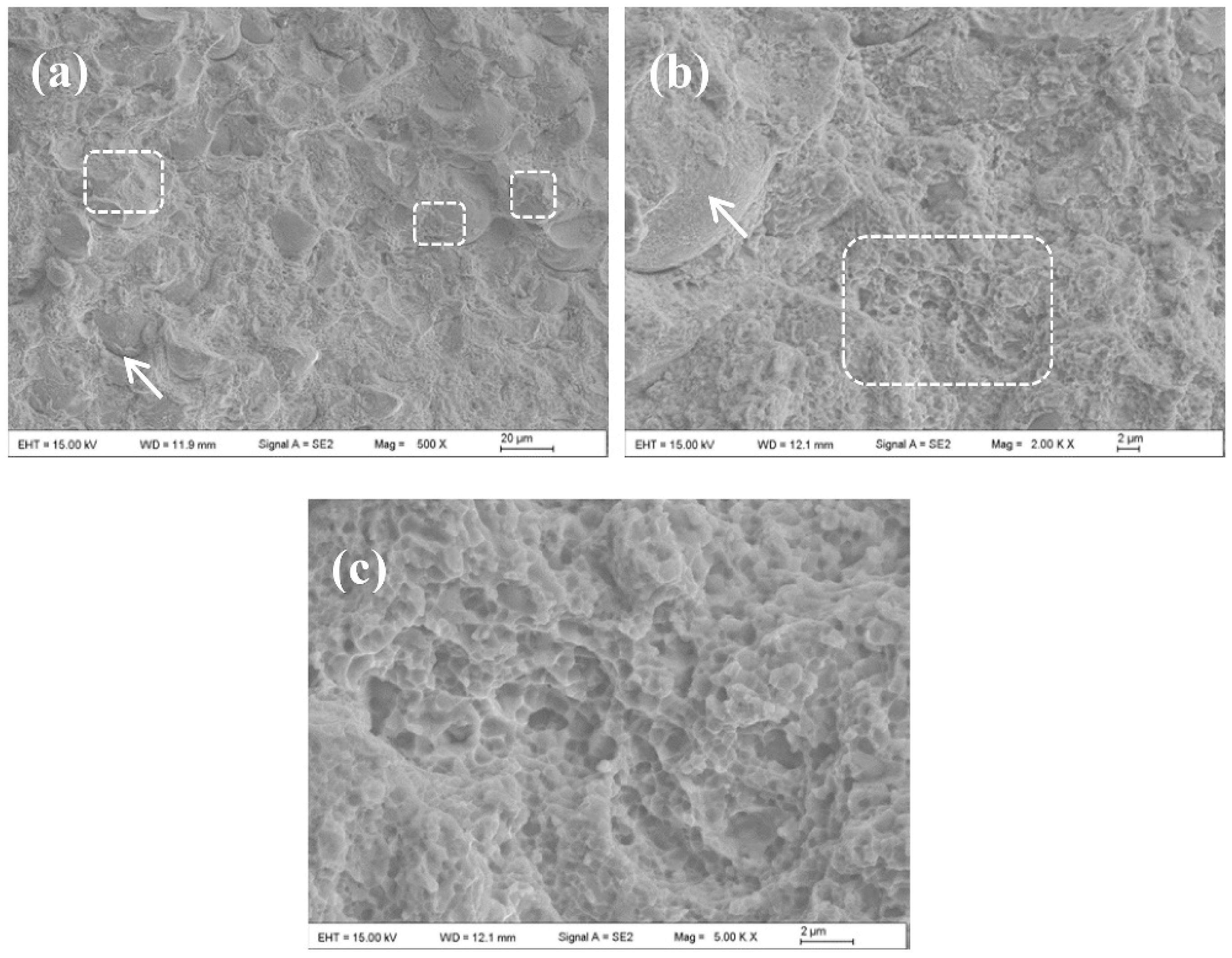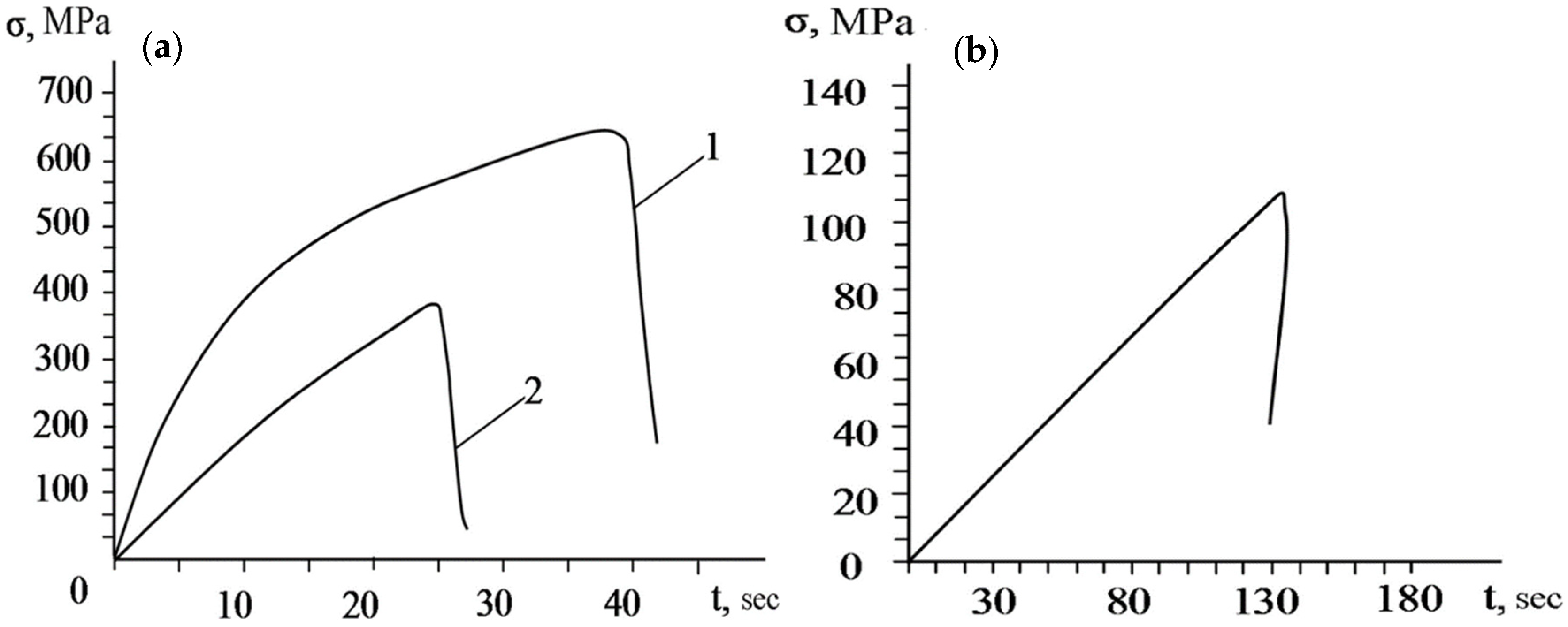1. Introduction
In recent years, with the rapid development of the aviation industry, lightweight design is a necessary guarantee to achieving low carbon emission and long-range flight. Light-metal alloys, such as aluminum (Al), magnesium (Mg), and titanium (Ti) alloys, have the advantages of low density and high specific strength [
1,
2,
3,
4,
5,
6]. In addition, Mg alloys have good electromagnetic shielding and high damping characteristics and have been widely used in carrier-based helicopters and fighter jets [
7,
8]. Due to their high strength and manufacturing feasibility, Al alloys are also widely used in civil aviation. As shown in
Table 1, Al alloys occupy a critical position in aircraft manufacturing [
9].
Figure 1 shows the specific use of Al alloys in the current mainstream wide-body passenger aircraft Boeing 777 [
9], including aircraft trusses, landing gear, aircraft skins, wing spars, and other structural parts as well as non-stressed parts such as seat rails and floors. Ti alloys are commonly used in aircraft structural parts, engine casings, aircraft landing gear, flame frames, and other bearing components [
10]. The tensile strength of Ti6Al4V alloys commonly used in aircraft structures is nearly 1 GPa [
11].
During the service period, the surface damage of light alloys caused by corrosion and wear seriously affects the aircraft’s flight safety and service life [
12,
13,
14]. Due to the high value of these parts, the manufacturers generally do not store spare parts. Therefore, repairing the damaged parts is the most efficient way to save maintenance time and cost, producing huge green and circular-economic benefits [
15].
2. Preparation of Coatings on the Surface of Aviation Parts
At present, the technologies for preparing alloy coatings on metallic surfaces mainly include thermal spraying technologies, such as high-velocity oxygen fuel spraying (HVOF) [
16,
17], arc spraying [
18,
19], plasma spraying [
20,
21,
22], and laser cladding (LC) [
23,
24]. The prepared coatings mainly include Fe-based, Cu-based, and Al-based coatings, and are mainly used for preparation of wear-resistant and anti-corrosion coatings, as seen in
Table 2. In the thermal spraying process, the alloy powder particles are heated to a molten or semi-molten state and then rapidly solidify to form a coating after being deposited on the surface of the substrate within a specific speed range. However, the rapid heating and cooling involved in the thermal spraying process can easily lead to problems of oxidation, phase transformation, compositional segregation, and the generation of shrinkage cavities, so the microstructure of sprayed coatings is relatively complex, usually containing oxide inclusions, un-melted particles, and pores that adversely affect the performance of the coating. For example, Wang et al. [
25] used HVOF technology to prepare a Fe-based alloy coating on the surface of Al alloy, and the analysis results showed that the coating had higher hardness and better wear performance than the Al alloy substrate, but there were transparent oxides and pores of different sizes on the particle interface in the coating. The larger pores were caused by molten particles entrapped in the air during flight, and small-sized pores were caused by shrinkage during rapid solidification. Zhang et al. [
26] studied the corrosion behavior of Fe-based alloy coatings prepared by HVOF in NaCl solution, and the results showed that the pitting phenomenon originated from the particle interface region in the coating. The reason for this phenomenon was that the oxidation during the spraying process led to the generation of the Cr element depletion area, and the potential difference between the Cr-depleted and Cr-rich areas caused corrosion. The production of oxides in the alloy coating destroys the compositional balance of the parent alloy and quickly leads to phase separation. In addition, high heat input will form residual tensile stress on the surface of the substrate, which can also cause severe component dilution at the coating–substrate interface. In addition, the residual tensile stress caused by thermal influence and phase transformation at the interface will cause the matrix to crack, forming obvious cracks. The initiation of cracks at the interface will significantly reduce the service life of repaired parts.
LC technology uses the characteristics of rapid heating and cooling of the laser source to prepare coatings [
29]. The energy density of the laser is usually between 10
4 and 10
6 W/cm
2, and the cooling rate of the molten pool can reach 10
4–10
6 K/s. The high energy density completely melts the surface of the cladding material and the substrate material, resulting in a skinny molten pool. The LC technology usually involves a large heat-affected zone (HAZ) on the substrate surface. At the same time, in the multi-pass cladding process, the repeated heating by the subsequent scanning quickly leads to grain growth of the deposited coating. Due to the vast heat input, there is a potential corrosion difference between the coating and the substrate, which leads to pitting corrosion at the interface, thereby reducing the corrosion resistance of the coating [
27], For example, Katakam et al. [
30] studied the corrosion behavior of LC Fe-based alloy coatings and showed the precipitation of carbide phases in the coatings, which reduced the corrosion resistance of the coatings. Li et al. [
31] investigated the corrosion properties of LC Ni-based alloy coatings and compared them with strips of the same composition and 316L stainless steel. The results showed that in the same corrosion environment, the corrosion potential of the LC layer was lower than that of the strip and 316L stainless steel. The reason is that the phase interface contained in the LC layer provides an effective diffusion channel for charge transfer during the corrosion process, which accelerates the penetration of the corrosion solution, thereby reducing the corrosion resistance of the coating.
In summary, in preparing alloy coatings, although the structure and properties of the coating can be optimized by adjusting the process parameters, it is still difficult to avoid high-temperature conditions that lead to adverse effects. In addition, the thermal damage by thermal spraying and LC technologies to the substrate surface is severe. The grain growth and composition segregation in the heat-affected zone will adversely affect the interface bonding between the coating and the substrate, seriously affecting the service performance of the repaired parts. Therefore, it is of great practical significance and theoretical innovation value to seek a new preparation method of alloy coating to eliminate the negative impact of high-temperature influence.
3. Preparation of Protective Coatings by Cold-Spray Technology
In the mid-1980s, when the Soviet Union scientist Anatolii Papyrin and his team studied the model of two-phase flow (gas + solid particles) in a wind tunnel, they found that when the speed of the solid particles was higher than a certain critical value, the matrix material would no longer be eroded and particles began to adhere to the matrix [
32]. Inspired by this phenomenon, Anatolii Papyrin and his team first proposed the concept of cold gas dynamic spraying (referred to as ‘cold spraying’) in 1990, which could be used as a new coating process. Later, they successfully deposited a variety of pure metals, metal alloys, and composites on different matrices, proving the possibility of cold-spraying technology in engineering applications [
32]. Cold-spray (CS) technology is characterized by low-temperature solid-state deposition [
33], and its process temperature is much lower than the melting temperature of the original powder material [
34,
35], which can effectively avoid the adverse effects of oxidation, phase transformation, and thermal cracking caused by high temperature [
36,
37,
38]. It is very suitable for preparing anti-corrosion and wear-resistant coatings on the surface of Al, Mg, and Ti alloys which are oxidation-sensitive [
39,
40,
41]. As shown in
Figure 2, the technical principle of CS technology is to use high-pressure inert gas nitrogen (N
2) or helium (He) as the energy source. The electric heater preheats the gas to a specific temperature to accelerate powder materials to a speed range of 500–1200 m/s through the supersonic nozzle. Particles undergo severe plastic deformation under high-speed impact to form coatings [
34,
42,
43]. As shown in
Figure 3, compared with the above-mentioned high-temperature coating-preparation technologies, such as HVOF, plasma spraying, and wire arc spray, CS has the characteristics of low process temperature and high spraying speed. The most important thing is that the particles will undergo significant plastic deformation during the deposition process compared with thermal spray coatings. Therefore, the coatings have extremely low porosity and high hardness, which are essential for improving the coatings’ wear and corrosion resistance [
44,
45,
46]. In addition, CS is also suitable for surface treatment of matrix materials with low melting points and easy oxidation, such as Al alloys, Mg alloys, and Ti alloys [
47]. Therefore, CS technology makes it possible to prepare high-performance coating materials on the surface of light alloy aircraft components.
In recent years, CS technology has been applied in the repair field of aircraft components, providing wear-resistant and corrosion-resistant coatings [
48,
49]. Mg is a very active electrochemical metal, and galvanic corrosion will occur when Mg alloys are combined with other structural metals in the presence of electrolytes or corrosive media [
50,
51]. The Al-based coatings prepared by CS technology have been applied to protect Mg alloy parts against corrosion. For example, Wei et al. [
48] prepared dense Al and Al alloy protective coatings on the surface of AZ31B Mg alloys by CS technology. The experimental results showed that the CS coating provided long-term solid corrosion protection for the AZ31B Mg alloy substrate. The experimental results are shown in
Figure 4. It can be seen that the protective coatings were still uniform and dense after 1000 h of corrosion experiments. Tao et al. [
49] deposited pure Al coating on AZ91D Mg alloys by CS technology. Electrochemical tests showed that cold-sprayed pure Al coating has better pitting-corrosion resistance in neutral 3.5 wt.% NaCl solution than bulk Al of similar purity, as shown in
Figure 5. It can be seen that the pitting-corrosion resistance of pure Al coating was better than that of bulk Al within ten days in a corrosive environment. This also proved that the cold-sprayed pure Al coating can be used as an anti-corrosion coating for the Al substrate. In the cold-sprayed Al alloy anti-corrosion protective coatings, Babu et al. [
52] used CS technology to deposit aerosolized Al amorphous/nanocrystalline alloy powder on 6061 Al alloy substrates. As shown in
Figure 6, the potentiodynamic polarization study showed that the thickness of the reaction layer formed during the salt spray corrosion tests was two to three times lower in the case of cold-sprayed Al amorphous/nanocrystalline coatings. The reaction-layer thickness of the heat-treated coating was further reduced. Pitting corrosion formed a porous oxide layer on the bare substrate surface, whereas uniform, dense, and thin corrosion layers were observed in sprayed and heat-treated coatings. Zhou et al. [
53] deposited HAP/Ti composite coating on Ti substrate by CS technique to study the electrochemical corrosion behavior of cold-sprayed 20 wt.% and 50 wt.% HAP/Ti composite coating. The research results showed that the CS technique was suitable for the fabrication of HAP/Ti composite protective coating on Ti substrates.
In terms of wear-resistant coatings, the most common method for preparing wear-resistant coatings by CS technology is to spray a metal matrix composite coating, a mixture of hard particles and softer ductile particles. The softer binder phase ensures the opportunity efficiency and coating quality of the CS coating, while the hard wear-resistant particles ensure the hardness and wear performance of the coating [
54,
55,
56]. For example, Chen et al. [
57] studied the tribological properties of cold-sprayed aluminum/diamond composite coatings on pure Al substrate. The results showed that aluminum/diamond composites had better wear resistance than selective laser sintering Inconel 625 and 17-4PH alloys. Higher diamond content in the composite resulted in better wear resistance. The friction and wear experiment results are shown in
Figure 7. Spencer et al. [
58] prepared Al-Al
2O
3 and 6061Al-Al
2O
3 coatings on the AZ91E Mg alloy substrate by cold-spraying technology. The study showed that compared with the substrate, the wear rate of the composite coating was significantly reduced. In aviation maintenance, Goldbaum et al. [
59] produced a bi-layer system using CS technology to improve the mechanical and frictional properties of repaired parts. This bi-layer system consisted of a cold-sprayed Ti coating and TiN, TiSiN, and TiSiCN HiPIMS protective coatings and demonstrated the use of the CS system for Ti friction-protective coatings.
4. Additive Manufacturing and Repair via Cold-Spray Technology
Additive manufacturing technology has changed the way products are manufactured and is a revolutionary breakthrough in the principles of manufacturing technology. Achieving the perfect integration of additive manufacturing and the overall configuration design of the structure is to give full play to the technological advantages of additive manufacturing. It is the key to breaking through the bottleneck of the traditional design mode and processing technology to reduce the structure’s weight further and improve its performance. The traditional additive manufacturing technology uses laser beams, electron beams, and arcs as heat sources to achieve the layer-by-layer formation of metal components by melting metal powders or wires. Depending on the energy source and the forming materials used, typical metal-additive manufacturing mainly includes selective laser melting (SLM) [
60], electron beam melting (EBM) [
61], electron beam freeform fabrication (EBFF) [
61], and laser metal deposition (LMD) [
62]. Since the processing temperature is higher than the material’s melting point, the traditional additive manufacturing process will cause problems, such as material oxidation, phase transition, decomposition, and grain growth, which significantly impact the final performance of the parts.
With the gradual improvement of the capabilities of CS equipment, this technology has now entered the field of 3D printing [
39,
63]. The US Army Research Laboratory (ARL) has an early research and application development of CS technology. In 2008, a corresponding technical standard (MIL-STD-3021) was proposed for the application of this technology in repairing damaged parts, marking that this technology had entered the stage of practical application in the field of military equipment [
64]. As reported by ARL, this technology is currently widely used to repair Al alloy and Mg alloy damaged parts caused by corrosion and wear, such as the UH-60 helicopter gearbox (ZE41A, AZ91 Mg alloy) and fuel tank bottom (7075 Al alloy) [
65,
66,
67,
68]. Champagne et al. [
69] used the CS process of 6061 Al alloy to join and provide a structural repair of cast ZE41A-T5 cast Mg. It demonstrated that the cold-spray process can produce dissimilar metal joints with comparable ultimate tensile strength, hardness, and shear strength to those of the repaired magnesium alloy. Cavaliere et al. [
70] used 2198 and 7075 Al alloy powders to CS repair the 2099 aviation Al alloy panel with a 30° V notch on the surface. The results showed that with 2198 Al alloy repair, the crack resistance increased by more than seven times, and CS repair helped increase the cracked structure’s overall fatigue life. Cavaliere et al. [
71] prepared Ti- and Ni-based nanocomposite coatings by CS technology for the repair study of Ti alloy substrates. The experimental results showed that CS could successfully deposit dense Ti coatings for repairing Ti alloy parts. Villafuerte et al. [
72,
73] reported the use of CS technology to repair aviation Al alloy components and for the on-site repair of aircraft landing gear, as shown in
Figure 8.
In 2019, Australia’s Titomic company successfully joined CSIRO (Australian Commonwealth Scientific and Industrial Research Organization) to apply CS technology to manufacturing and developed a new 3D printing process—Kinetic Fusion. This process can print Ti alloys in the same way as other existing metal 3D printing processes, but with better performance, and the printing speed can reach 45 kg/h (about 10–100 times higher than traditional additive manufacturing technology). Compared with traditional laser 3D printing, the tensile strength of the finished product printed by this process was increased by 34%. In 2018, Titomic agreed with TAUV to use Titomic’s 3D printing technology to produce Ti alloy rugged soldier uncrewed aerial vehicles (UAVs). The tactical drone market was estimated to be worth AUD 545 million in 2018, according to The Teal Group. Titomic’s first defense drone project demonstrated the advanced manufacturing capabilities of CS technology to produce complex-shaped products with improved performance characteristics. Not only does Titomic Kinetic Fusion make a difference in making metal parts, but it also prints these parts at a considerable scale with a large-scale CS 3D printer capable of printing everything from golf clubs to complex aircraft-wing parts.
At the same time, the literature [
63] reported that the General Electric Company (GE) of the United States used CS technology to manufacture completely new parts. For example, gears were fabricated by controlling nozzle movement and external motor drive, and the prepared gears are shown in
Figure 9. United Technologies Research Center [
74] also produced steel brackets by CS additive manufacturing technology. The research center sprayed the structure on the formed mandrel substrate, removed the substrate, and finally finished the bracket to obtain a steel bracket that met the requirements of use. The finished product is shown in
Figure 10.
In 2017, Akron University in Ohio, USA, cooperated with Aviation Maintenance Engineering Services (AMES) to develop CS 3D printing technology for repairing aircraft parts. A related license application was submitted to the Federal Aeronautics Administration (FAA) in the same year. In 2019, Rowan University in New Jersey received $14.5 million from the ARL to develop the Cold Spray Additive Manufacturing (CSAM) program. The materials developed through the research program can be used in the military field so that the military equipment can be lightweight to meet the requirements of use. In 2020, the European Space Agency (ESA) awarded up to GBP 500,000 to researchers in the Department of Mechanical and Manufacturing Engineering at Trinity College Dublin, Ireland, to research CS 3D printing. Nowadays, CS technology is not only used in coating preparation. Due to the unique advantages of this technology, this technology has been applied in the military field abroad. It also has market shares in some civilian fields, such as non-stick pans and printing auto parts. At the same time, commercialization sectors such as civil aviation, automotive, healthcare, and space exploration are also potential customers.
5. Interfacial Bond Strength between Cold-Sprayed Coatings and Substrates
The interface bonding strength between the coating and the substrate (adhesive strength) is a crucial factor affecting the overall service performance of the part. To obtain a coating with excellent bonding strength with the substrate, the preferred material for surface repair of parts is the coating material that is consistent with, or close to, the composition of the substrate. However, due to the high activity of Mg alloys, Mg powder is flammable and explosive in the process of CS, so the surface repair of Mg alloy parts is made of Al alloy powder materials [
64].
Table 3 [
75,
76,
77,
78,
79] lists the interfacial bonding strength (tensile and shear strength) and the cohesive strength of the coating material of CS Al-based coatings on the aviation Al alloy and Mg alloy surface, which are compared with the tensile strength of the substrate. It can be seen that the interface bonding strength between the coating and the substrate is much lower than the cohesive force of the coating and the bulk strength of the substrate material, and the coating is easy to peel off at the interface, which seriously affects the integrity of the coating and the substrate during service.
The fundamental reason for the low bond strength between the CS coating and the substrate is the lack of adequate metallurgical bonding at the interface. Studies have revealed that the interfacial bonding between the CS coating and the substrate is characterized by mechanical interlocking and local metallurgical bonding [
42,
80,
81]. To improve the bonding strength of the interface, scholars have conducted much research, among which there are two main methods for improving the effectiveness. One is to generate a diffusion layer between the coating and the substrate by post-annealing. The phase structure of the diffusion layer depends on the reaction characteristics between the coating and the matrix material [
82]. Still, the heat treatment will affect the matrix material’s original structure and properties, so it is unsuitable for the treatment of repair parts. The other is to add hard ceramic particles during the coating preparation and use the pinning effect of the hard particles at the coating–substrate interface to improve the bonding strength. However, during the deposition process, the hard ceramic particles significantly impact the surface of the substrate, which quickly leads to the generation of microcracks [
79]. Therefore, for repairing aviation Al alloy and Mg alloy parts, scholars are looking for new ways to improve the interface bonding strength between the coating and the substrate to ensure integrity during service.
Through experimental research, Wang and others [
39] found that introducing an interfacial bonding transition layer effectively improves the bonding strength between the coating and the substrate. The basic principle of material selection for the bonding transition layer is that it has good chemical activity with both the coating and the substrate and can produce a good interface metallurgical bond with the coating and the substrate during the deposition process of spraying. In widely used aviation Al alloys (such as Al-Zn-Mg-Cu series 7050 and 7075 alloys), Mg alloys (such as Mg-Zn-RE series ZE41 and Mg-Al-Zn series AZ91 alloys), zinc (Zn) is the main alloy component. The solid solubility of Zn in Al varies widely, and the highest solid solubility at the eutectic temperature (381 °C) can reach 83.1% (mass ratio). The crystal structures of Zn and Mg are both close-packed hexagonal structures, and Mg solid solubility of Zn in Mg is 6.2% (mass ratio), and the eutectic temperature is 340 °C. Al-Zn and Zn bonding layers were prepared between the pure Al coating and the interface of 7050 Al alloy and AZ91 Mg alloy substrate, and the bonding strength was significantly improved, as shown in
Table 4. The results showed that the interface bonding state between Zn and Al and Zn and Mg can be effectively controlled by adjusting the temperature and speed of the particles during the CS process by using the chemical affinity between Zn, Al, and Mg elements. The interface bonding state between Zn and Al and Zn and Mg can be effectively controlled, a good element diffusion metallurgical bonding layer can be obtained, and the interface bonding strength between the coating and the substrate can be improved. Li et al. [
83] reported the preparation of Zn coatings by CS on the surface of mild steel. As shown in
Figure 11, with the increase of the spraying gas temperature, the melting degree of the Zn coating surface gradually increases. The melting phenomenon is caused by particle impact (impact-induced melting), which effectively improves the interfacial bonding strength between the Zn coating and the substrate and the cohesion of the Zn coating.
The introduction of texture design on the surface of the substrate can increase the interface contact area and mechanical occlusion between the coating and the substrate and effectively improve the interface bonding strength between the coating and the substrate. Compared with grinding, ion beam, electrical discharge machining, and other methods, laser machining has a series of advantages, such as high machining accuracy, high efficiency, low pollution, small heat-affected zone, and wide application range [
84,
85]. Kromer et al. [
86] studied the influence of the laser processing surface micro-texture on the interfacial bonding strength between CS coating and Al alloy substrate. The study designed textures with two different pore-arrangement densities, as shown in
Figure 12. The interfacial bond strength of the microtextured samples can be increased up to 300% (Al-alloy) compared to the samples with the surface treated by sandblasting, as shown in
Figure 13. Combined with the fracture morphology analysis, the pore structure of the surface micro-texture not only affects the interface bonding strength between the coating and the substrate, but can also change the fracture mechanism between the coating and the substrate to make it transition from the interface fracture to the internal fracture of the coating, as shown in
Figure 14. Therefore, it is of great significance to systematically study the influence of the pore design of the surface micro-texture on the bonding strength and fracture mechanism of the CS coating–substrate interface.
6. Preparation of Coatings by Supersonic Laser Deposition Technology
Although the hole pattern design of the surface micro-texture improves the interface bonding strength between the coating and the substrate, the introduction of texture design on the surface of the substrate is cumbersome, and the operation on complex surfaces is difficult. According to the deposition principle of CS technology, the deposition and forming of CS coating are based on the plastic deformation of metal powder materials under high-speed impact, so the powder raw materials need good plasticity [
39]. Therefore, it is necessary to find new ways to improve the plasticity of the powder, so that the hard powder can be better deposited and formed, given the shortcomings of CS technology in the process of preparing hard metallic coatings, such as low deposition efficiency, poor coating density, and low bonding strength.
The supersonic laser deposition technology (SLD) is a novel materials-deposition technique which applies a laser source to assist the cold spraying process [
87,
88,
89,
90]. The principle of SLD is shown in
Figure 15 [
78,
91]. O’Neill et al. revealed that the simultaneous softening of hard metallic particles by laser can improve the thickness, deposition efficiency, density, and bonding strength of the cold-sprayed coatings. Under the assistance of laser heat, CS can use low-cost nitrogen instead of helium to prepare high-quality coatings with high hardness [
90]. Therefore, the cost of coating preparation is reduced, and the selection range of deposition materials is broadened. In recent years, the attraction of SLD technology has increased significantly [
92]. Yao et al. [
93] used SLD technology and LC technology to prepare hard Ni60 (58–62 HRC) coating on medium carbon steel (AISI 1045 steel) substrate. The results showed that the Ni60 coating prepared by the SLD technology exhibits some characteristics that are better than the coating produced by the traditional LC process, such as fine microstructure, less dilution, and better sliding wear resistance. However, the deposition of hard Ni60 on the steel substrate cannot be achieved by CS technology. Dallin et al. [
94] used CS and SLD technology to prepare AISI4340 coating on the surface of the AISI1018 stainless steel substrate. As shown in
Figure 16, under the condition of the same spraying process parameters, except for the laser source, the thickness of the CS coating was only 1.7 mm, while the thickness of the SLD coating was 3.5 mm with the deposition rate increase from 48% to 72%. The porosity of the SLD coating was less than 1%. The porosity was found to be slightly higher in the CS deposit than in the SLD deposits with complete bonding between the deposit and the substrate, the coating was denser, and the structure was more uniform. At the same time, due to the laser’s synchronous heating effect, the coating’s hardness was reduced from 561 HV to 466 HV, which effectively alleviated the deformation hardening effect caused by the particle deposition process. Li et al. [
95] conducted the solid-state fabrication of continuous and dense WC/Stellite-6 composite coatings by SLD technology. The results of friction and wear tests revealed that the SLD coating had fewer defects and better friction and wear properties compared to the coating prepared by LC, as shown in
Figure 17. The bonding mechanism in SLD evolves from predominantly mechanical bonding in CS to co-existence of mechanical and metallurgical bonding. As shown in
Figure 18, Yao et al. [
78] conducted three-point bending experiments of SLD Stellite6 coating and found that the maximum load of the deposited layer sample was 81.4% that of the cast sample. The fracture morphology showed apparent dimples and tear bands, indicating that the bonding mode between particles was metallurgical bonding. As shown in
Figure 19. Gorunov et al. [
96,
97] prepared 316L stainless steel coatings on stainless steel bars by SLD technology. After testing, the tensile strength of the coating was 650 MPa, and the interface bonding strength between the coating and the substrate could reach 105 MPa.
Table 5 presents the performance comparison of coatings prepared by different technologies. It can be noted that no new phase is produced in the process of SLD coating and CS coating. In contrast, unnecessary phase transformations will occur in LC coating, which will affect the performance and density of the coating. In addition, the average hardness of SLD coating is higher than that of CS coating and LC coating. The friction and corrosion resistance of SLD coatings are better than those of LC coatings, indicating that that SLD technology has certain potential and advantages in the field of coating preparation.
From the research work of the above scholars, it can be seen that SLD technology can effectively overcome the shortcomings of CS technology and effectively improve the interface bonding strength between the coating and the substrate, the strength of the coating itself, and the fatigue performance of the coating. Compared with coating technologies such as thermal spraying and laser cladding, SLD technology inherits the advantages of CS technology, such as high deposition speed, small heat affected zone, and dense coating. SLD technology reduces the critical deposition speed of particles, thereby reducing the gas consumption of the equipment during use, improving the deposition efficiency, and reducing the operating cost of CS technology. According to the above analysis, the future SLD technology will have excellent development prospects and possibilities in preparing high-quality coatings in field of repairing and additive manufacturing of aircraft components.
7. Current Challenges and Future Prospects
In summary, compared with traditional coating-preparation technologies, such as flame spraying, arc spraying, and plasma spraying, as well as laser-cladding technology, CS technology can effectively avoid oxidation, phase transformation, thermal cracking, and matrix cracking at the interface caused by thermal influence. At the same time, additive manufacturing through CS technology also has a broad application in rapid production of aircraft parts. SLD technology offsets the shortcomings of CS technology and shows certain advantages in preparing high quality alloy coatings with high hardness. However, CS and SLD technologies still face many challenges in field of aviation application.
(1) CS technology has gradually matured in the additive manufacturing and repair of aviation parts, but there are relatively few types of materials at this stage. More materials need to be tested in future work to form a complete guide map, in terms of coating materials and process parameters.
(2) As an emerging technology, the study of coatings prepared by SLD technology is mainly on the functional properties of friction, wear, and corrosion properties, while there are few studies on the mechanical properties of coatings. In future research, the focus should be placed on the mechanical properties of bonding strength and fatigue performance which are of great importance in aviation applications.
(3) The supersonic powder stream and high-energy laser beams are key players in SLD process. Therefore, it is necessary to use the simulation method combined with experiments to understand the interaction between the kinetic energy and thermal energy conversion of powder materials during the deposition process, in order to precisely control the condition of powder deposition. In addition, the bonding mechanisms of SLD coatings needs to be explored.
Author Contributions
N.L.: Methodology, Validation, Formal analysis, Investigation, Writing—review & editing, Writing—original draft. Q.W.: Conceptualization, Methodology, Supervision, Project administration, Funding acquisition. F.D.: Validation, Formal analysis, Data curation, Funding acquisition. X.L.: Validation, Formal analysis, Resources, Data curation. P.H.: Validation, Formal analysis. Y.H.: Data curation, Formal analysis. All authors have read and agreed to the published version of the manuscript.
Funding
This research received no external funding.
Institutional Review Board Statement
Not applicable.
Informed Consent Statement
Not applicable.
Data Availability Statement
Not applicable.
Conflicts of Interest
The authors declare no conflict of interest.
References
- Martin, J.H.; Yahata, B.D.; Hundley, J.M.; Mayer, J.A.; Schaedler, T.A.; Pollock, T.M. 3D printing of high-strength aluminium alloys. Nature 2017, 549, 365–369. [Google Scholar] [CrossRef] [PubMed]
- He, S.; Chen, S.; Zhao, Y.; Qi, N.; Zhan, X. Study on the intelligent model database modeling the laser welding for aerospace aluminum alloy. J. Manuf. Process. 2021, 63, 121–129. [Google Scholar] [CrossRef]
- Cao, F.; Song, G.-L.; Atrens, A. Corrosion and passivation of magnesium alloys. Corros. Sci. 2016, 111, 835–845. [Google Scholar] [CrossRef]
- Chen, J.; Ma, B.; Feng, S.; Dai, Y.; Liu, G.; Song, H.; Jia, L. Preparation and application of 420 martensitic stainless steel wear resistant coating on magnesium alloy by cold spraying. Surf. Eng. 2018, 35, 351–359. [Google Scholar] [CrossRef]
- Wang, Q.; Zhang, K.; Qiu, D.; Niu, W. Additive manufacturing of high-strength commercially pure titanium through lanthanum oxide addition. Mater. Charact. 2021, 176, 111074. [Google Scholar] [CrossRef]
- Wang, L.; Song, Z.; Zhang, X.; Park, J.-S.; Almer, J.; Zhu, G.; Chen, Y.; Li, Q.; Zeng, X.; Li, Y. Developing ductile and isotropic Ti alloy with tailored composition for laser powder bed fusion. Addit. Manuf. 2022, 52, 102656. [Google Scholar] [CrossRef]
- Feng, X.; Sun, Y.; Wan, S.; Chen, G.; He, J. Effects of Aging Process on the Damping Performance of ZK60 Magnesium Alloys Prepared by Large Strain Rolling. Materials 2020, 13, 5574. [Google Scholar] [CrossRef]
- Liu, L.; Chen, X.; Pan, F. A review on electromagnetic shielding magnesium alloys. J. Magnes. Alloy. 2021, 9, 1906–1921. [Google Scholar] [CrossRef]
- Starke, E.A., Jr.; Staley, J.T. Application of modern aluminum alloys to aircraft. Prog. Aerosp. Sci. 1996, 32, 131–172. [Google Scholar] [CrossRef]
- Zhao, Q.; Sun, Q.; Xin, S.; Chen, Y.; Wu, C.; Wang, H.; Xu, J.; Wan, M.; Zeng, W.; Zhao, Y. High-strength titanium alloys for aerospace engineering applications: A review on melting-forging process. Mater. Sci. Eng. A 2022, 845, 143260. [Google Scholar] [CrossRef]
- Waqas, M.; He, D.; Liu, Y.; Riaz, S.; Afzal, F. Effect of Heat Treatment on Microstructure and Mechanical Properties of Ti6Al4V Alloy Fabricated by Selective Laser Melting. J. Mater. Eng. Perform. 2022, 190, 106042. [Google Scholar] [CrossRef]
- Revilla, R.I.; Verkens, D.; Rubben, T.; De Graeve, I. Corrosion and Corrosion Protection of Additively Manufactured Aluminium Alloys—A Critical Review. Materials 2020, 13, 4804. [Google Scholar] [CrossRef] [PubMed]
- Li, B.; Zhang, Z.; Liu, T.; Qiu, Z.; Su, Y.; Zhang, J.; Lin, C.; Wang, L. Recent Progress in Functionalized Coatings for Corrosion Protection of Mag-nesium Alloys—A Review. Materials 2022, 15, 3912. [Google Scholar] [CrossRef] [PubMed]
- Joseph, S.; Kontis, P.; Chang, Y.; Shi, Y.; Raabe, D.; Gault, B.; Dye, D. A cracking oxygen story: A new view of stress corrosion cracking in titanium alloys. Acta Mater. 2022, 227, 117687. [Google Scholar] [CrossRef]
- Aziz, N.A.; Adnan, N.A.A.; Wahab, D.A.; Azman, A.H. Component design optimisation based on artificial intelligence in support of additive manufacturing repair and restoration: Current status and future outlook for remanufacturing. J. Clean. Prod. 2021, 296, 126401. [Google Scholar] [CrossRef]
- Hu, W.; Li, M.; Fukumoto, M. Preparation and properties of HVOF NiAl nanostructured coatings. Mater. Sci. Eng. A 2008, 478, 1–8. [Google Scholar] [CrossRef]
- Hearley, J.; Little, J.; Sturgeon, A. The effect of spray parameters on the properties of high velocity oxy-fuel NiAl intermetallic coatings. Surf. Coat. Technol. 2000, 123, 210–218. [Google Scholar] [CrossRef]
- Pokhmurska, H.; Dovhunyk, V.; Student, M.; Bielanska, E.; Beltowska, E. Tribological properties of arc sprayed coatings obtained from FeCrB and FeCr-based powder wires. Surf. Coat. Technol. 2002, 151, 490–494. [Google Scholar] [CrossRef]
- Wang, X.; He, D.; Guo, X.; Zhou, Z.; Wang, G.; Guo, F. Hot corrosion behavior of wire-arc sprayed NiCrB coatings. Surf. Coat. Technol. 2019, 367, 173–178. [Google Scholar] [CrossRef]
- Sidhu, B.S.; Prakash, S. Evaluation of the corrosion behaviour of plasma-sprayed Ni3Al coatings on steel in oxidation and molten salt environments at 900 °C. Surf. Coat. Technol. 2003, 166, 89–100. [Google Scholar] [CrossRef]
- Jia, Q.; Li, D.; Li, S.; Zhang, Z.; Zhang, N. High-Temperature Oxidation Resistance of NiAl Intermetallic Formed In Situ by Thermal Spraying. Coatings 2018, 8, 292. [Google Scholar] [CrossRef]
- Wang, Q.; Rui, X.; Wang, Q.-J.; Bai, Y.; Du, Z.-Z.; Niu, W.-J.; Wang, W.; Wang, K.-S.; Gao, Y. Bonding and wear behaviors of supersonic plasma sprayed Fe-based coatings on Al-Si alloy substrate. Surf. Coat. Technol. 2019, 367, 288–301. [Google Scholar] [CrossRef]
- Yu, Z.; Hass, D.; Wadley, H. NiAl bond coats made by a directed vapor deposition approach. Mater. Sci. Eng. A 2005, 394, 43–52. [Google Scholar] [CrossRef]
- Wang, H.-X.; Zhang, Y.; Cheng, J.-L.; Li, Y.-S. High temperature oxidation resistance and microstructure change of aluminized coating on copper substrate. Trans. Nonferrous Met. Soc. 2015, 25, 184–190. [Google Scholar] [CrossRef]
- Wang, Q.; Li, X.; Niu, W.; Rui, X.; Mao, X.; Li, Y.; Yang, J. Effect of MoS2 content on microstructure and properties of supersonic plasma sprayed Fe-based composite coatings. Surf. Coat. Technol. 2020, 391, 125699. [Google Scholar] [CrossRef]
- Zhang, C.; Chan, K.; Wu, Y.; Liu, L. Pitting initiation in Fe-based amorphous coatings. Acta Mater. 2012, 60, 4152–4159. [Google Scholar] [CrossRef]
- Tan, C.; Zhu, H.; Kuang, T.; Shi, J.; Liu, H.; Liu, Z. Laser cladding Al-based amorphous-nanocrystalline composite coatings on AZ80 magnesium alloy under water cooling condition. J. Alloys Compd. 2017, 690, 108–115. [Google Scholar] [CrossRef]
- Stoyanov, P.; Harrington, K.M.; Frye, A. Insights into the Tribological Characteristic of Cu-Based Coatings Under Extreme Contact Conditions. JOM 2020, 72, 2191–2197. [Google Scholar] [CrossRef]
- Zhu, L.; Xue, P.; Lan, Q.; Meng, G.; Ren, Y.; Yang, Z.; Xu, P.; Liu, Z. Recent research and development status of laser cladding: A review. Opt. Laser Technol. 2021, 138, 106915. [Google Scholar] [CrossRef]
- Katakam, S.; Santhanakrishnan, S.; Dahotre, N.B. Fe-Based Amorphous Coatings on AISI 4130 Structural Steel for Corrosion Resistance. JOM 2012, 64, 709–715. [Google Scholar] [CrossRef]
- Li, R.; Li, Z.; Zhu, Y.; Qi, K. Structure and corrosion resistance properties of Ni-Fe-B-Si-Nb amorphous composite coatings fabricated by laser processing. J. Alloys Compd. 2013, 580, 327–331. [Google Scholar] [CrossRef]
- Papyrin, A.; Kosarev, V.; Klinkov, S.; Alkimov, A.; Fomin, V. Cold Spray Technology. Adv. Mater. Process. 2001, 159, 49–51. [Google Scholar]
- Cong, D.; Li, Z.; He, Q.; Chen, H.; Zhao, Z.; Zhang, L.; Wu, H. Wear behavior of corroded Al-Al2O3 composite coatings prepared by cold spray. Surf. Coat. Technol. 2017, 326, 247–254. [Google Scholar] [CrossRef]
- Assadi, H.; Kreye, H.; Gärtner, F.; Klassen, T. Cold spraying-A materials perspective. Acta Mater. 2016, 116, 382–407. [Google Scholar] [CrossRef]
- Li, W.; Cao, C.; Yin, S. Solid-state cold spraying of Ti and its alloys: A literature review. Prog. Mater. Sci. 2019, 110, 100633. [Google Scholar] [CrossRef]
- Champagne, V.; Helfritch, D. The unique abilities of cold spray deposition. Int. Mater. Rev. 2016, 61, 437–455. [Google Scholar] [CrossRef]
- Wang, Q.; Zhang, M.X. Review on Recent Research and Development of Cold Spray Technologies. Key Eng. Mater. 2012, 533, 1–52. [Google Scholar] [CrossRef]
- Yin, S.; Cavaliere, P.; Aldwell, B.; Jenkins, R.; Liao, H.; Li, W.; Lupoi, R. Cold spray additive manufacturing and repair: Fundamentals and applications. Addit. Manuf. 2018, 21, 628–650. [Google Scholar] [CrossRef]
- Wang, Q.; Sun, Q.; Zhang, M.-X.; Niu, W.-J.; Tang, C.-B.; Wang, K.-S.; Rui, X.; Zhai, L.; Wang, L. The influence of cold and detonation thermal spraying processes on the microstructure and properties of Al-based composite coatings on Mg alloy. Surf. Coat. Technol. 2018, 352, 627–633. [Google Scholar] [CrossRef]
- Xiong, Y.; Zhuang, W.; Zhang, M. Effect of the thickness of cold sprayed aluminium alloy coating on the adhesive bond strength with an aluminium alloy substrate. Surf. Coat. Technol. 2015, 270, 259–265. [Google Scholar] [CrossRef]
- Li, W.-Y.; Li, J.; Zhang, C.; Liao, H.; Coddet, C. Characterizations of Cold-Sprayed Nickel-Alumina Composite Coating with Relatively Large Nickel-Coated Alumina Powder. Surf. Coat. Technol. 2008, 202, 4855–4860. [Google Scholar] [CrossRef]
- Assadi, H.; Gärtner, F.; Stoltenhoff, T.; Kreye, H. Bonding mechanism in cold gas spraying. Acta Mater. 2003, 51, 4379–4394. [Google Scholar] [CrossRef]
- Qiu, X.; Haq Tariq, N.U.; Wang, J.-Q.; Tang, J.-R.; Gyansah, L.; Zhao, Z.; Xiong, T. Microstructure, microhardness and tribological behavior of Al2O3 reinforced A380 aluminum alloy composite coatings prepared by cold spray technique. Surf. Coat. Technol. 2018, 350, 391–400. [Google Scholar] [CrossRef]
- Tan, A.W.-Y.; Lek, J.Y.; Sun, W.; Bhowmik, A.; Marinescu, I.; Buenconsejo, P.J.; Dong, Z.; Liu, E. Microstructure, mechanical and tribological properties of cold sprayed Ti6Al4V–CoCr composite coatings. Compos. Part B-Eng. 2020, 202, 108280. [Google Scholar] [CrossRef]
- Ma, C.; Liu, X.; Zhou, C. Cold-Sprayed Al Coating for Corrosion Protection of Sintered NdFeB. J. Therm. Spray Technol. 2013, 23, 456–462. [Google Scholar] [CrossRef]
- Xie, C.; Li, H.; Zhou, X.; Sun, C. Corrosion behavior of cold sprayed pure zinc coating on magnesium. Surf. Coat. Technol. 2019, 374, 797–806. [Google Scholar] [CrossRef]
- Ang, A.S.M.; Sanpo, N.; Sesso, M.L.; Kim, S.Y.; Berndt, C.C. Thermal Spray Maps: Material Genomics of Processing Technologies. J. Therm. Spray Technol. 2013, 22, 1170–1183. [Google Scholar] [CrossRef]
- Wei, Y.-K.; Luo, X.-T.; Ge, Y.; Chu, X.; Huang, G.-S.; Li, C.-J. Deposition of fully dense Al-based coatings via in-situ micro-forging assisted cold spray for excellent corrosion protection of AZ31B magnesium alloy. J. Alloys Compd. 2019, 806, 1116–1126. [Google Scholar] [CrossRef]
- Tao, Y.; Xiong, T.; Sun, C.; Kong, L.; Cui, X.; Li, T.; Song, G.-L. Microstructure and corrosion performance of a cold sprayed aluminium coating on AZ91D magnesium alloy. Corros. Sci. 2010, 52, 3191–3197. [Google Scholar] [CrossRef]
- Prince, L.; Rousseau, M.-A.; Noirfalise, X.; Dangreau, L.; Coelho, L.; Olivier, M.-G. Inhibitive effect of sodium carbonate on corrosion of AZ31 magnesium alloy in NaCl solution. Corros. Sci. 2020, 179, 109131. [Google Scholar] [CrossRef]
- Gray-Munro, J.; Luan, B.; Huntington, L. The influence of surface microchemistry in protective film formation on multi-phase magnesium alloys. Appl. Surf. Sci. 2008, 254, 2871–2877. [Google Scholar] [CrossRef]
- Babu, P.S.; Venkatesh, L.; Jyothirmayi, A.; Suresh, K.; Krishna, L.R.; Agarwal, A.; Rao, D.S. Salt Spray (Fog) Corrosion Behavior of Cold-Sprayed Aluminum Amorphous/Nanocrystalline Alloy Coating. J. Therm. Spray Technol. 2022, 31, 1173–1183. [Google Scholar] [CrossRef]
- Zhou, X.; Mohanty, P. Electrochemical behavior of cold sprayed hydroxyapatite/titanium composite in Hanks’ solution. Electrochim. Acta 2012, 65, 134–140. [Google Scholar] [CrossRef]
- Poirier, D.; Legoux, J.-G.; Drew, R.A.L.; Gauvin, R. Consolidation of Al2O3/Al Nanocomposite Powder by Cold Spray. J. Ther. Spray Technol. 2011, 20, 275–284. [Google Scholar] [CrossRef]
- Irissou, E.; Legoux, J.; Arsenault, B.; Moreau, C. Investigation of Al-Al2O3 Cold Spray Coating Formation and Properties. J. Ther. Spray Technol. 2007, 16, 661–668. [Google Scholar] [CrossRef]
- Tao, Y.; Xiong, T.; Sun, C.; Jin, H.; Du, H.; Li, T. Effect of α-Al2O3 on the properties of cold sprayed Al/α-Al2O3 composite coatings on AZ91D magnesium alloy. Appl. Surf. Sci. 2009, 256, 261–266. [Google Scholar] [CrossRef]
- Chen, C.; Xie, Y.; Yan, X.; Ahmed, M.; Lupoi, R.; Wang, J.; Ren, Z.; Liao, H.; Yin, S. Tribological properties of Al/diamond composites produced by cold spray additive manufacturing. Addit. Manuf. 2020, 36, 101434. [Google Scholar] [CrossRef]
- Spencer, K.; Fabijanic, D.M.; Zhang, M.-X. The use of Al–Al2O3 cold spray coatings to improve the surface properties of magnesium alloys. Surf. Coat. Technol. 2009, 204, 336–344. [Google Scholar] [CrossRef]
- Goldbaum, D.; Manimuda, P.; Kamath, G.; Descartes, S.; Klemberg-Sapieha, J.E.; Chromik, R.R. Tribological behavior of TiN and Ti (Si,C)N coatings on cold sprayed Ti substrates. Surf. Coat. Technol. 2016, 291, 264–275. [Google Scholar] [CrossRef]
- Foroozmehr, A.; Badrossamay, M.; Foroozmehr, E.; Golabi, S. Finite Element Simulation of Selective Laser Melting process con-sidering Optical Penetration Depth of laser in powder bed. Mater. Des. 2016, 89, 255–263. [Google Scholar] [CrossRef]
- Chen, G.; Shu, X.; Liu, J.; Zhang, B.; Feng, J. Crystallographic texture and mechanical properties by electron beam freeform fabrication of copper/steel gradient composite materials. Vacuum 2020, 171, 109009. [Google Scholar] [CrossRef]
- Cao, S.; Gu, D. Laser metal deposition additive manufacturing of TiC/Inconel 625 nanocomposites: Relation of densification, microstructures and performance. J. Mater. Res. 2015, 30, 3616–3628. [Google Scholar] [CrossRef]
- Li, W.; Yang, K.; Yin, S.; Yang, X.; Xu, Y.; Lupoi, R. Solid-state additive manufacturing and repairing by cold spraying: A review. J. Mater. Sci. Technol. 2018, 34, 440–457. [Google Scholar] [CrossRef]
- Champagne, V.; Gabriel, B.; Villafuerte, J. Cold spray coatings to improve the corrosion resistance of magnesium (Mg) alloys. In Corrosion Prevention of Magnesium Alloys; Song, G.-L., Ed.; Woodhead Publishing: Soston, UK, 2013; pp. 414–445. [Google Scholar]
- Champagne, V.K. The Repair of Magnesium Rotorcraft Components by Cold Spray. J. Fail. Anal. Prev. 2008, 8, 164–175. [Google Scholar] [CrossRef]
- Rokni, M.; Widener, C.; Champagne, V.; Crawford, G. Microstructure and mechanical properties of cold sprayed 7075 deposition during non-isothermal annealing. Surf. Coat. Technol. 2016, 276, 305–315. [Google Scholar] [CrossRef]
- Widener, C.A.; Carter, M.J.; Ozdemir, O.C.; Hrabe, R.H.; Hoiland, B.; Stamey, T.E.; Champagne, V.K.; Eden, T.J. Application of High-Pressure Cold Spray for an Internal Bore Repair of a Navy Valve Actuator. J. Therm. Spray Technol. 2015, 25, 193–201. [Google Scholar] [CrossRef]
- Helfritch, D.; Champagne, V. A Model Study of Powder Particle Size Effects in Cold Spray Deposition. In Proceedings of the 26th Army Science Conference, Orlando, FL, USA, 1–4 December 2008. [Google Scholar]
- Champagne, V., Jr.; Kaplowitz, D.; Iii, V.C.; Howe, C.; West, M.K.; McNally, B.; Rokni, M. Dissimilar metal joining and structural repair of ZE41A-T5 cast magnesium by the cold spray (CS) process. Mater. Manuf. Process. 2017, 33, 130–139. [Google Scholar] [CrossRef]
- Cavaliere, P.; Silvello, A. Crack Repair in Aerospace Aluminum Alloy Panels by Cold Spray. J. Therm. Spray Technol. 2017, 26, 661–670. [Google Scholar] [CrossRef]
- Cavaliere, P.; Silvello, A. Mechanical properties of cold sprayed titanium and nickel based coatings. Surf. Eng. 2016, 32, 670–676. [Google Scholar] [CrossRef]
- Villafuerte, J. Recent trends in cold spray technology: Looking at the future. Surf. Eng. 2013, 26, 393–394. [Google Scholar] [CrossRef]
- Villafuerte, J. Current and future applications of cold spray technology. Met. Finish. 2010, 108, 37–39. [Google Scholar] [CrossRef]
- Nardi, A.; (United Technologies Research Center, East Hartford, CT, USA). UTRC Presentation. 2013.
- Sun, W.; Tan, A.W.Y.; Marinescu, I.; Toh, W.Q.; Liu, E. Adhesion, tribological and corrosion properties of cold-sprayed CoCrMo and Ti6Al4V coatings on 6061-T651 Al alloy. Surf. Coat. Technol. 2017, 326, 291–298. [Google Scholar] [CrossRef]
- Astarita, A.; Durante, M.; Langella, A.; Montuori, M.; Squillace, A. Mechanical characterization of low-pressure cold-sprayed metal coatings on alu-minium. Surf. Interface Anal. 2013, 45, 1530–1535. [Google Scholar] [CrossRef]
- Rokni, M.; Widener, C.; Crawford, G.; West, M. An investigation into microstructure and mechanical properties of cold sprayed 7075 Al deposition. Mater. Sci. Eng. A 2015, 625, 19–27. [Google Scholar] [CrossRef]
- Yao, J.; Li, Z.; Li, B.; Yang, L. Characteristics and bonding behavior of Stellite 6 alloy coating processed with supersonic laser dep-osition. J. Alloys Compd. 2016, 661, 526–534. [Google Scholar] [CrossRef]
- Wang, Q.; Spencer, K.; Birbilis, N.; Zhang, M.-X. The influence of ceramic particles on bond strength of cold spray composite coatings on AZ91 alloy substrate. Surf. Coat. Technol. 2010, 205, 50–56. [Google Scholar] [CrossRef]
- Hussain, T.; McCartney, G.; Shipway, P.H.; Zhang, D. Bonding Mechanisms in Cold Spraying: The Contributions of Metallurgical and Mechanical Components. J. Therm. Spray Technol. 2009, 18, 364–379. [Google Scholar] [CrossRef]
- Wang, Q.; Birbilis, N.; Zhang, M.-X. Interfacial structure between particles in an aluminum deposit produced by cold spray. Mater. Lett. 2011, 65, 1576–1578. [Google Scholar] [CrossRef]
- Wang, Q.; Birbilis, N.; Zhang, M.-X. On the Formation of a Diffusion Bond from Cold-Spray Coatings. Met. Mater. Trans. A 2012, 43, 1395–1399. [Google Scholar] [CrossRef]
- Li, W.-Y.; Li, C.-J.; Yang, G.-J. Effect of impact-induced melting on interface microstructure and bonding of cold-sprayed zinc coating. Appl. Surf. Sci. 2010, 257, 1516–1523. [Google Scholar] [CrossRef]
- Bañon, F.; Sambruno, A.; Batista, M.; Simonet, B.; Salguero, J. Surface Quality and Free Energy Evaluation of s275 Steel by Shot Blasting, Abrasive Water Jet Texturing and Laser Surface Texturing. Metals 2020, 10, 290. [Google Scholar] [CrossRef]
- Conradi, M.; Kocijan, A.; Klobčar, D.; Godec, M. Influence of Laser Texturing on Microstructure, Surface and Corrosion Properties of Ti-6Al-4V. Metals 2020, 10, 1504. [Google Scholar] [CrossRef]
- Kromer, R.; Costil, S.; Verdy, C.; Gojon, S.; Liao, H. Laser surface texturing to enhance adhesion bond strength of spray coatings-Cold spraying, wire-arc spraying, and atmospheric plasma spraying. Surf. Coat. Technol. 2018, 352, 642–653. [Google Scholar] [CrossRef]
- Li, B.; Yao, J.; Zhang, Q.; Li, Z.; Yang, L. Microstructure and tribological performance of tungsten carbide reinforced stainless steel composite coatings by supersonic laser deposition. Surf. Coat. Technol. 2015, 275, 58–68. [Google Scholar] [CrossRef]
- Bray, M.; Cockburn, A.; O’Neill, W. The Laser-assisted Cold Spray process and deposit characterisation. Surf. Coat. Technol. 2009, 203, 2851–2857. [Google Scholar] [CrossRef]
- Bray, M.; Cockburn, A.; O’Neill, W. Recent developments of the laser-assisted cold spray process and deposit characterisation. In Pacific International Conference on Applications of Lasers and Optics; Laser Institute of America: Orlando, FL, USA, 2008; pp. 457–462. [Google Scholar]
- Lupoi, R.; Sparkes, M.; Cockburn, A.; O’Neill, W. High speed titanium coatings by supersonic laser deposition. Mater. Lett. 2011, 65, 3205–3207. [Google Scholar] [CrossRef]
- Lupoi, R.; Cockburn, A.; Bryan, C.; Sparkes, M.; Luo, F.; O’Neill, W. Hardfacing steel with nanostructured coatings of Stellite-6 by supersonic laser deposition. Light. Sci. Appl. 2012, 1, 10. [Google Scholar] [CrossRef]
- Olakanmi, E.O.; Doyoyo, M. Laser-Assisted Cold-Sprayed Corrosion- and Wear-Resistant Coatings: A Review. J. Ther. Spray Technol. 2014, 23, 765–785. [Google Scholar] [CrossRef]
- Yao, J.; Yang, L.; Li, B.; Li, Z. Characteristics and performance of hard Ni60 alloy coating produced with supersonic laser deposition technique. Mater. Des. 2015, 83, 26–35. [Google Scholar] [CrossRef]
- Barton, D.J.; Bhattiprolu, V.S.; Thompson, G.B.; Brewer, L.N. Laser assisted cold spray of AISI 4340 steel. Surf. Coat. Technol. 2020, 400, 126218. [Google Scholar] [CrossRef]
- Li, B.; Jin, Y.; Yao, J.; Li, Z.; Zhang, Q. Solid-state fabrication of WCp-reinforced Stellite-6 composite coatings with supersonic laser deposition. Surf. Coat. Technol. 2017, 321, 386–396. [Google Scholar] [CrossRef]
- Gorunov, A.I. Investigation microstructure and fracture behavior of welded stainless steel specimens previously obtained by supersonic laser deposition. Manuf. Process. 2020, 56, 746–756. [Google Scholar] [CrossRef]
- Gorunov, A.I.; Gilmutdinov, A.K. Investigation of coatings of austenitic steels produced by supersonic laser deposition. Opt. Laser Technol. 2017, 88, 157–165. [Google Scholar] [CrossRef]
- Zhang, Q.; Wu, L.; Zou, H.; Li, B.; Zhang, G.; Sun, J.; Wang, J.; Yao, J. Correlation between microstructural characteristics and cavitation resistance of Stellite-6 coatings on 17-4 PH stainless steel prepared with supersonic laser deposition and laser cladding. J. Alloys Compd. 2021, 860, 158417. [Google Scholar] [CrossRef]
| Publisher’s Note: MDPI stays neutral with regard to jurisdictional claims in published maps and institutional affiliations. |
© 2022 by the authors. Licensee MDPI, Basel, Switzerland. This article is an open access article distributed under the terms and conditions of the Creative Commons Attribution (CC BY) license (https://creativecommons.org/licenses/by/4.0/).
